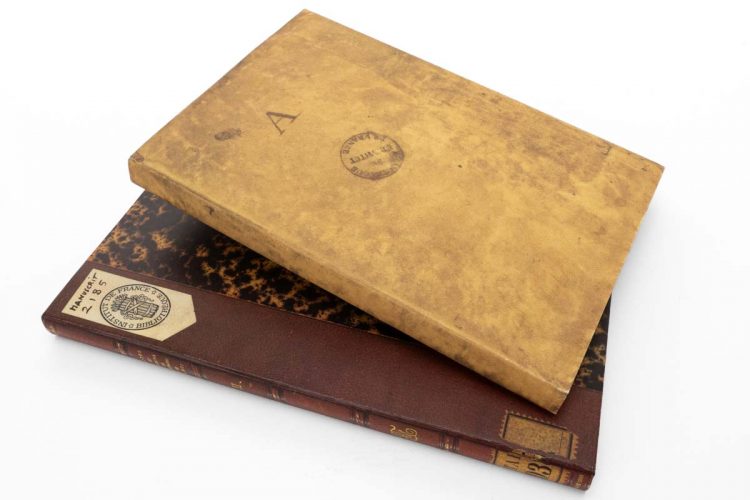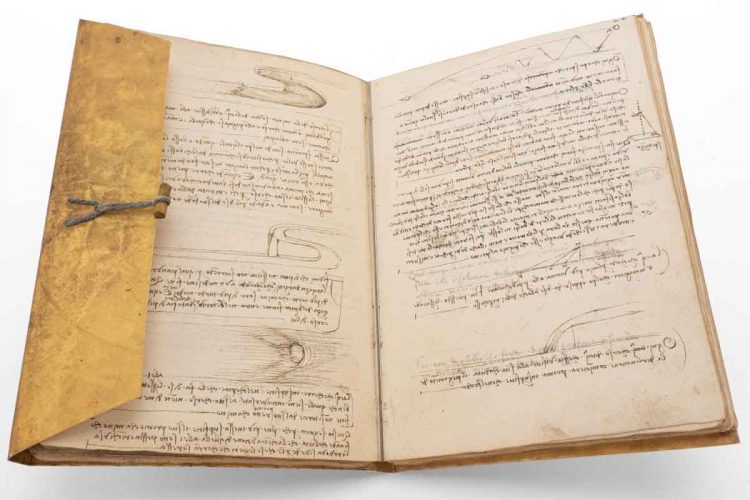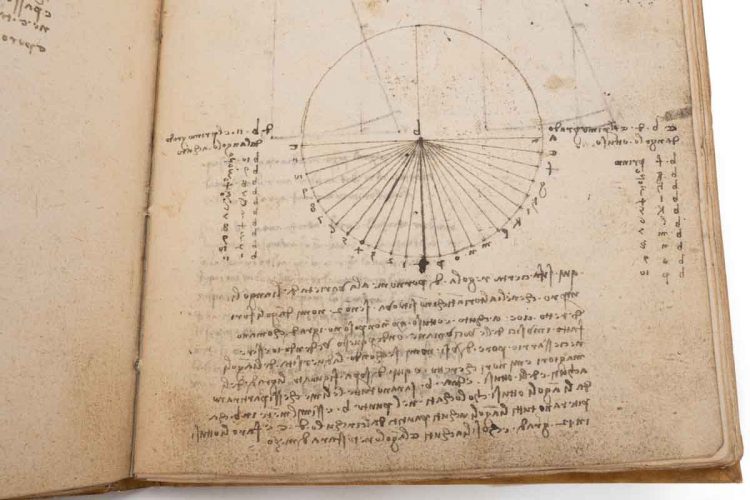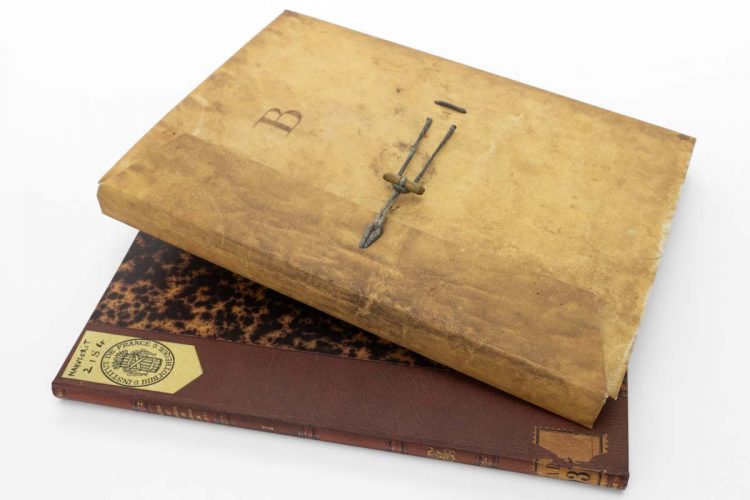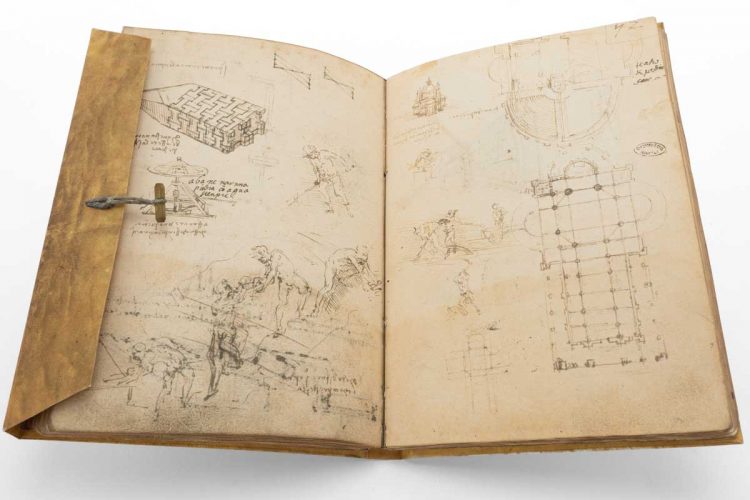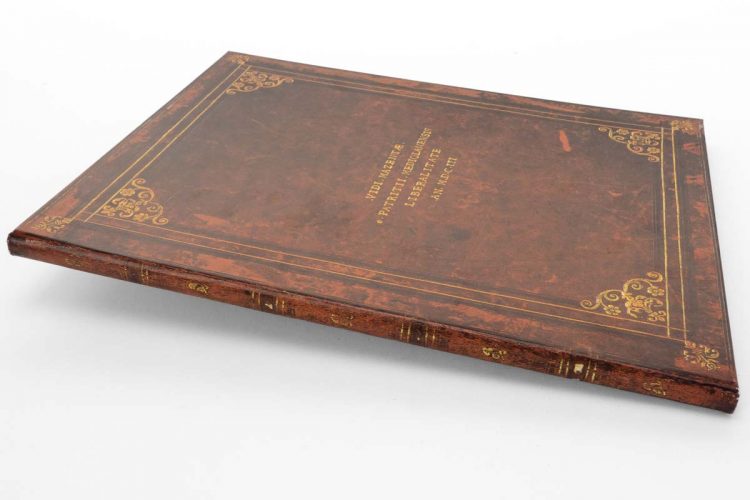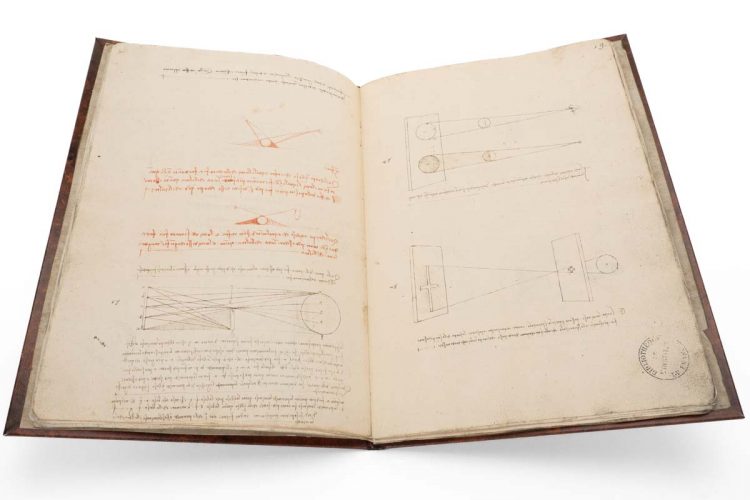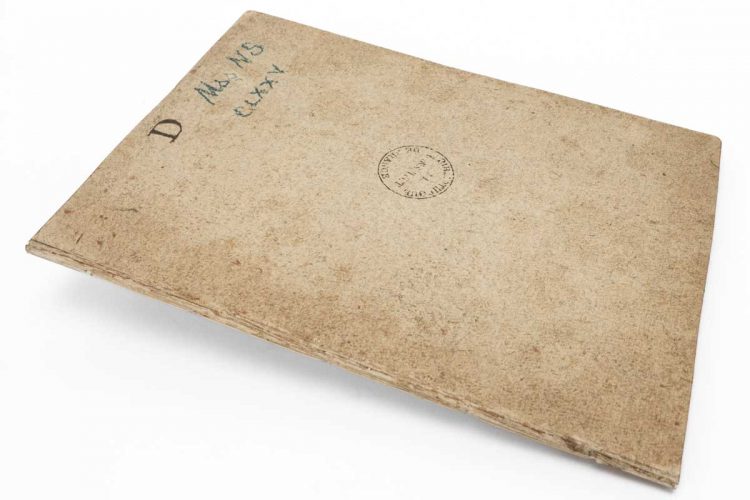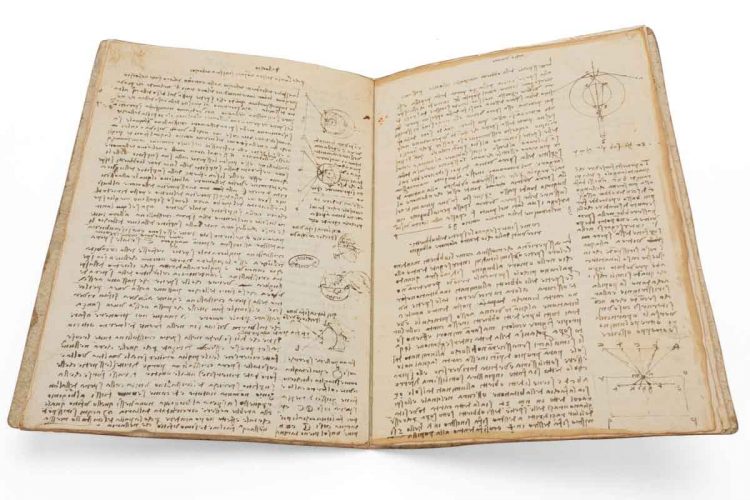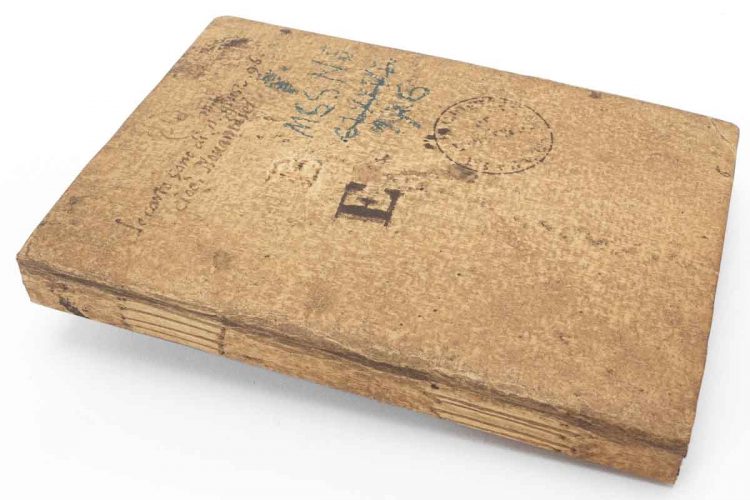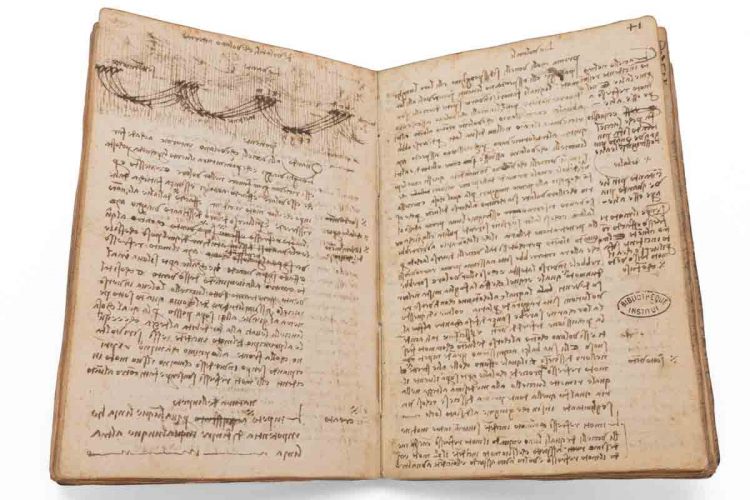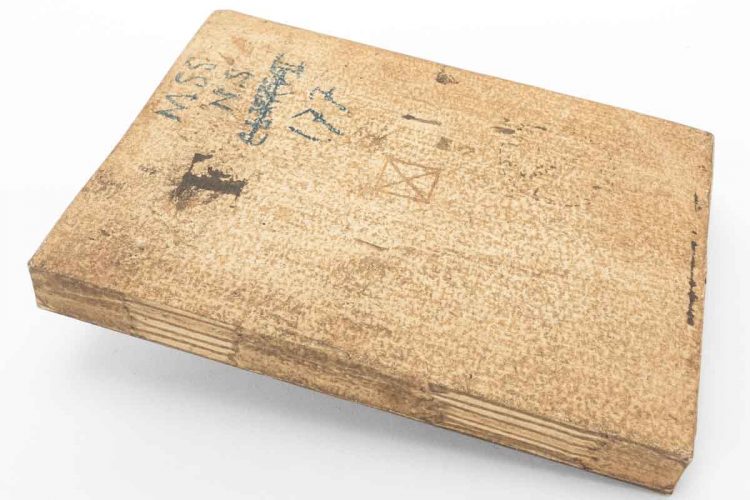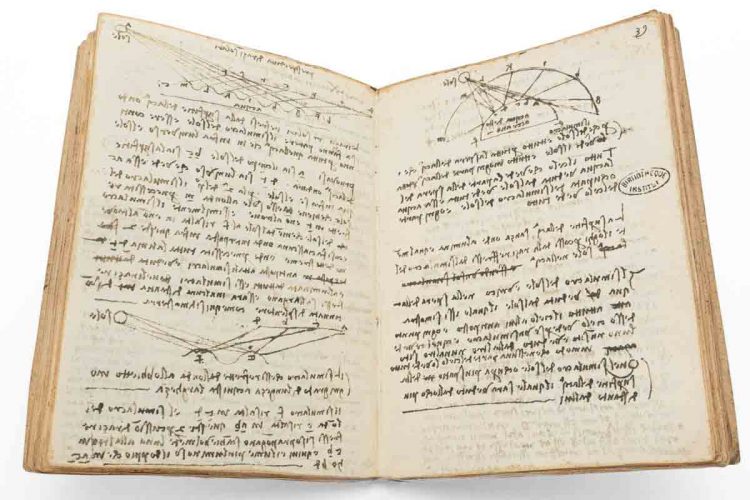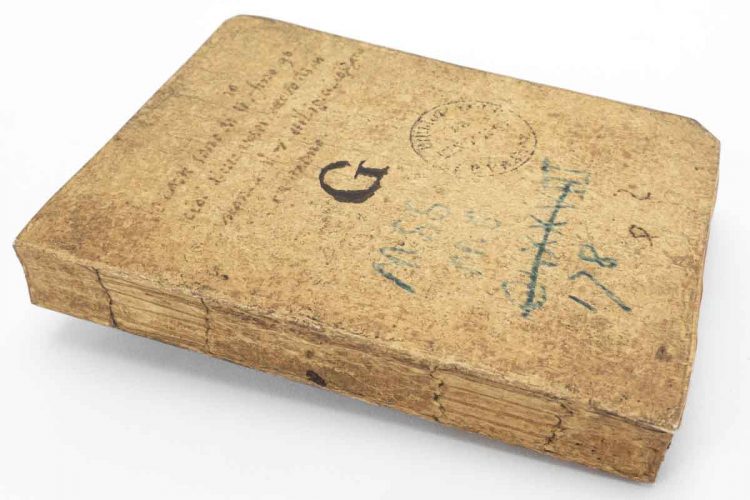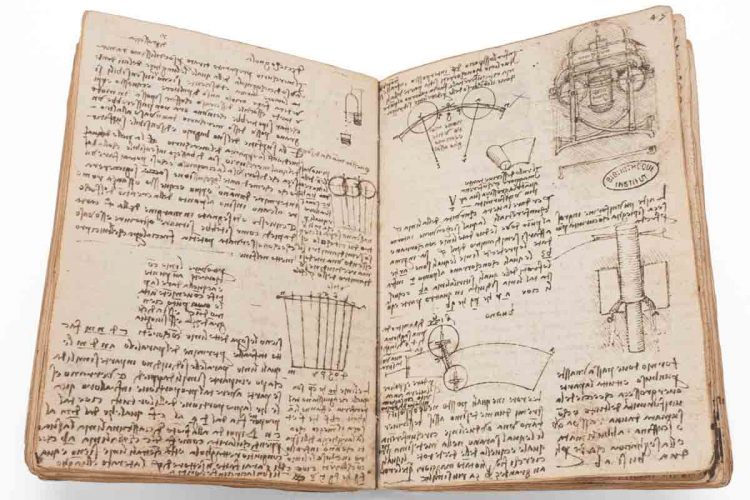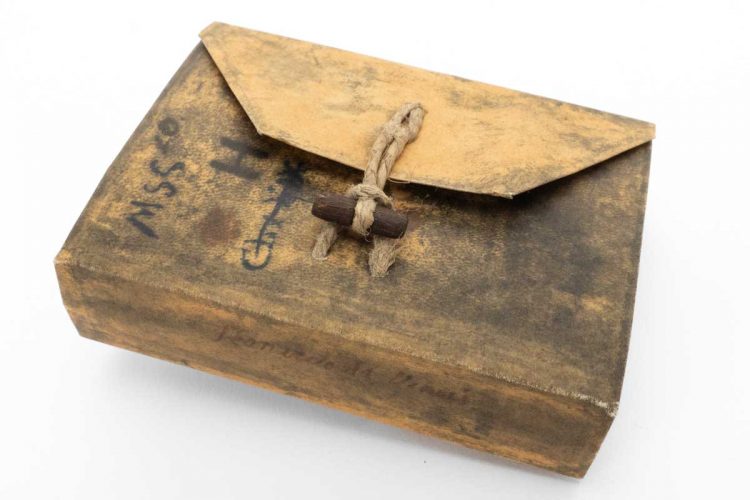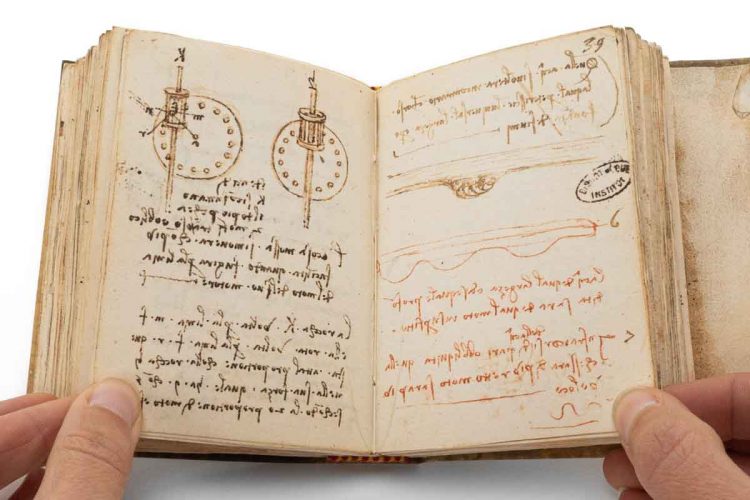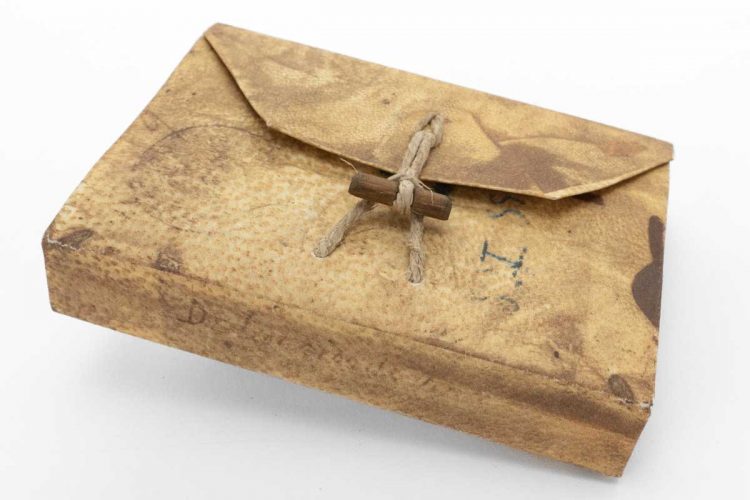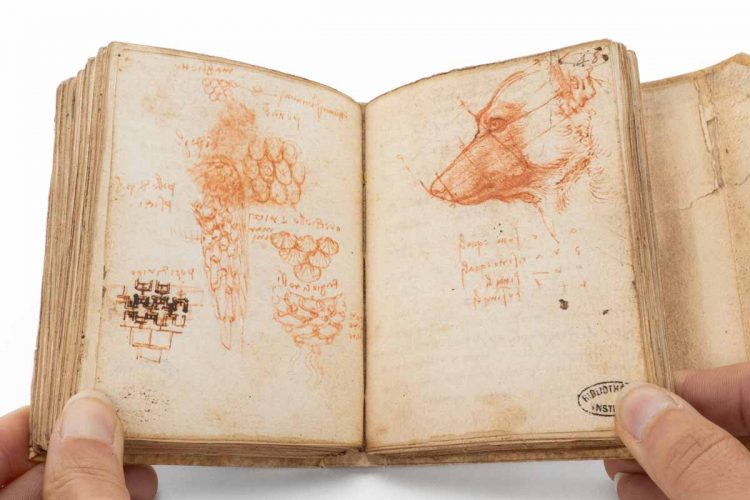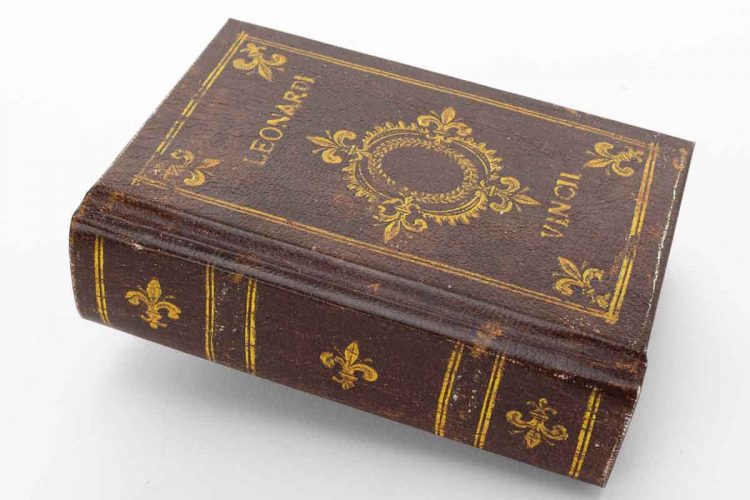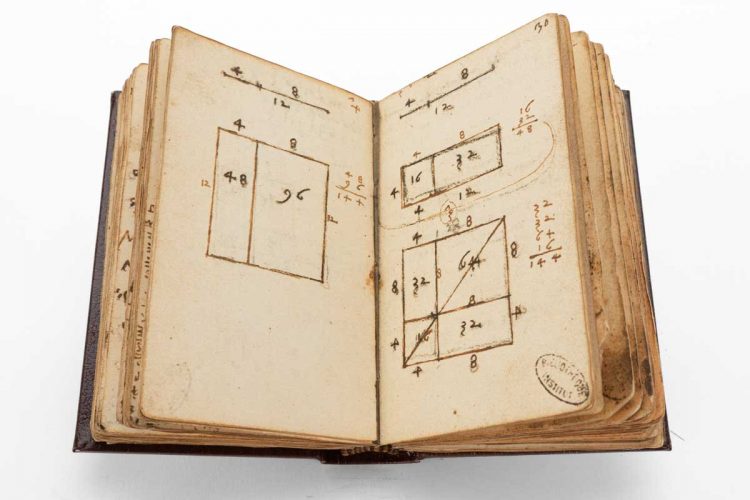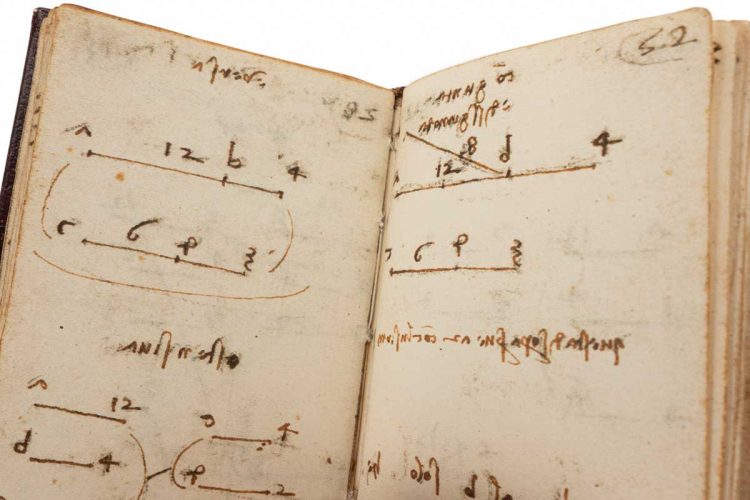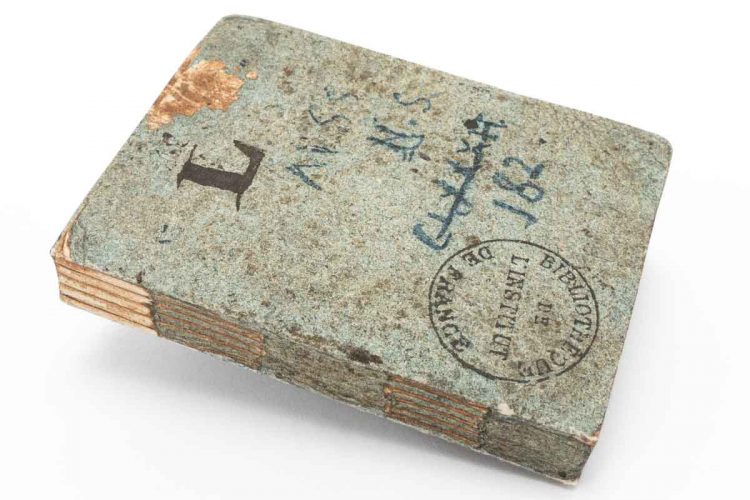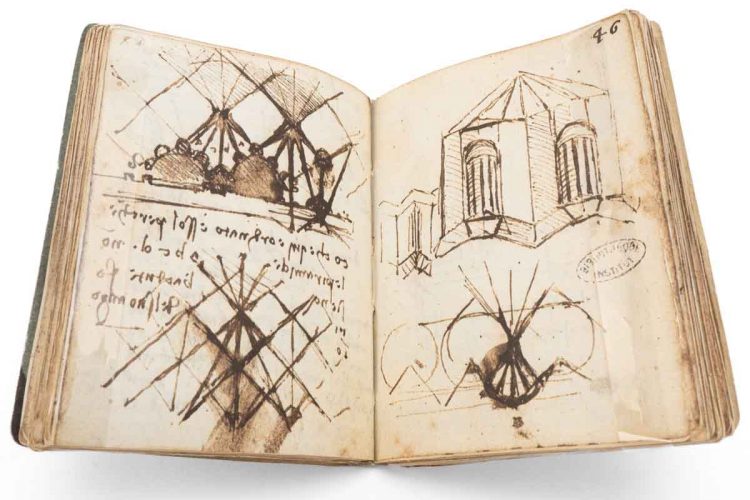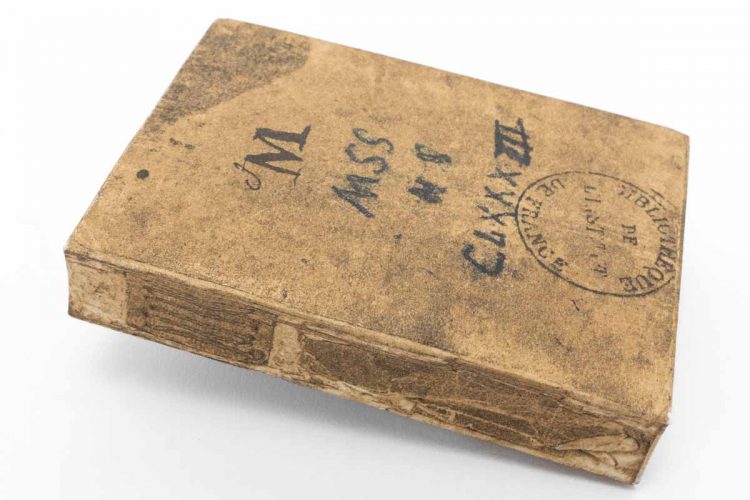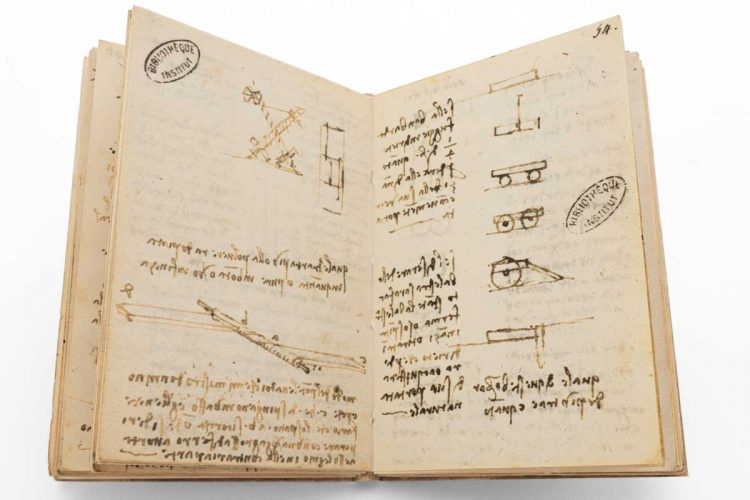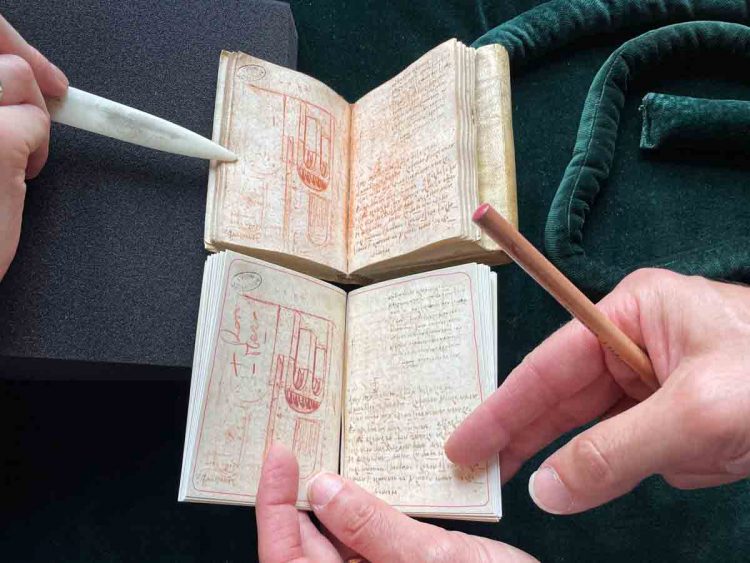These twelve meticulously preserved notebooks span nearly three decades of Leonardo’s life, offering a rare glimpse into the genius’s relentless curiosity and boundless creativity. From intricate sketches of flying machines to profound treatises on optics and anatomy, each page brims with the timeless wisdom of a visionary ahead of his time. A surprise awaits you at the end of this article!
Hidden within the hallowed halls of the Institut de France lie twelve extraordinary notebooks, dating from around 1487 to 1508. Unlike the artistic masterpieces we associate with their creator, these notebooks reveal the full spectrum of Leonardo da Vinci’s genius—a visionary scientist, engineer, and thinker. Some are so small they could easily slip into his pocket, yet their pages brim with intricate notes, sketches, and drafts of treatises on a plethora of subjects, many still shrouded in mystery.
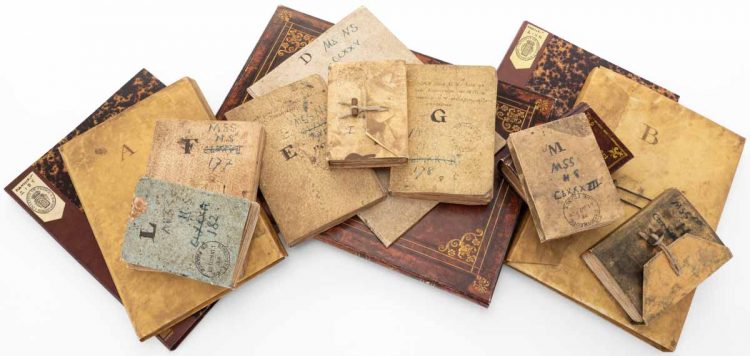
Leonardo’s unique writing style, a product of his left-handedness, flows in reverse from right to left, penned in an Italian interspersed with the Lombard dialect. His idiosyncratic spelling, devoid of punctuation or accents, adds another layer of intrigue to his words. By the late 18th century, these notebooks were organized with labels from A to M, a classification that endures to this day, preserving the enigmatic legacy of one of history’s greatest minds.
Let’s delve into each of the notebooks to uncover the periods of his scientific and artistic evolution, and the matters that intrigued him at the time of their compilation. Each manuscript has a different story, most often related to Napoleon’s transfer of works of art from conquered countries to France around the year 1800.
Exploring the Notebooks: A Complete Guide
Manuscript A
Around 1490, at less than forty years old, Leonardo da Vinci sketched a Treatise on Painting in this notebook. It also includes texts for other scientific and technical books on mechanics, hydrodynamics, architecture, and sculpture.
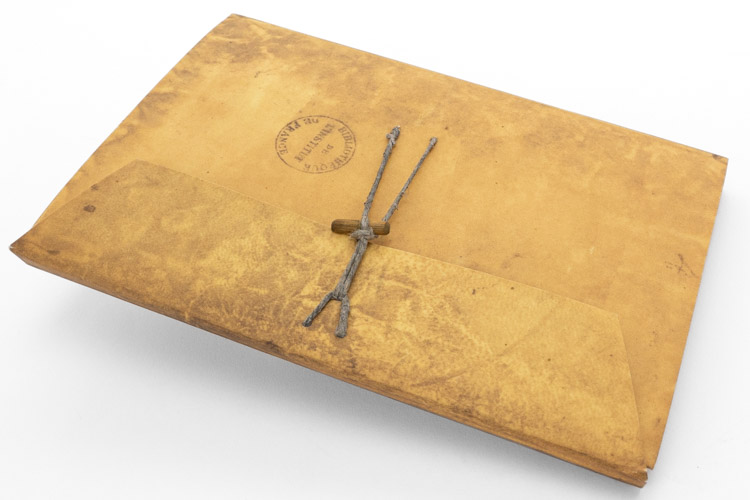
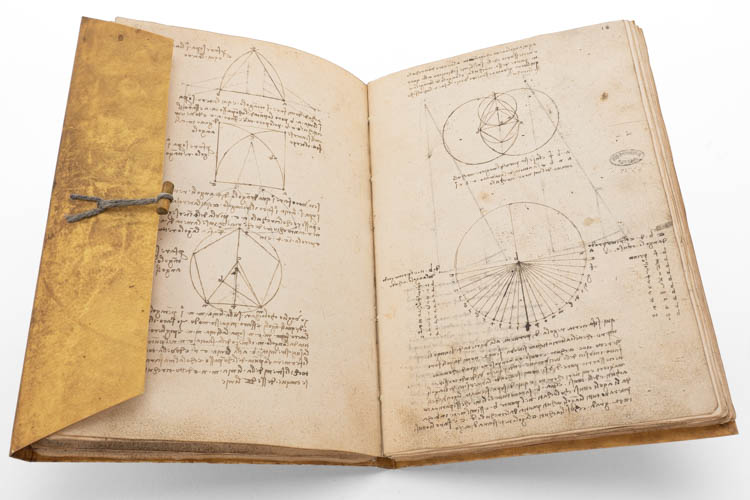
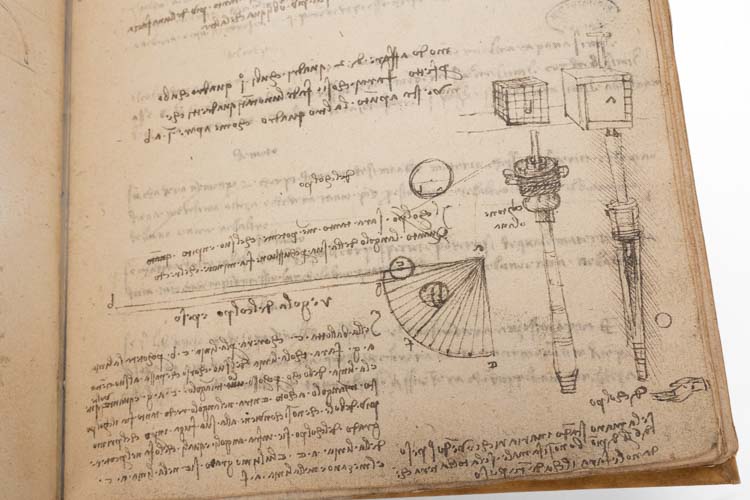
Manuscript B
The oldest of the twelve, dating from 1487-1489, shows Leonardo’s interest in both civil and military architecture, as well as flying machines.
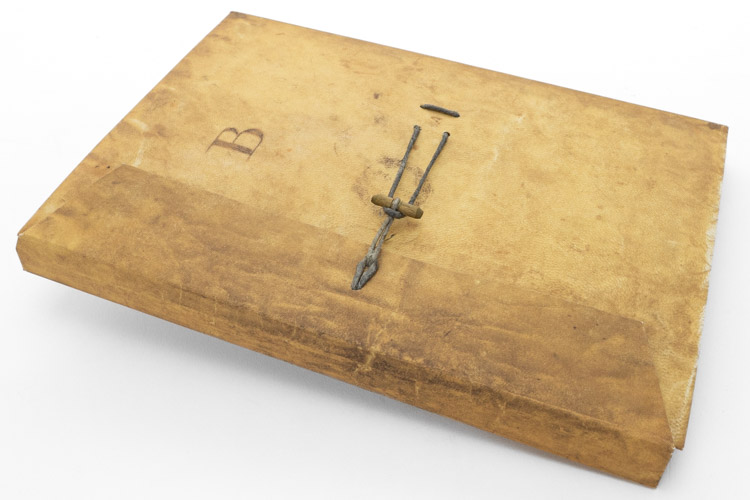
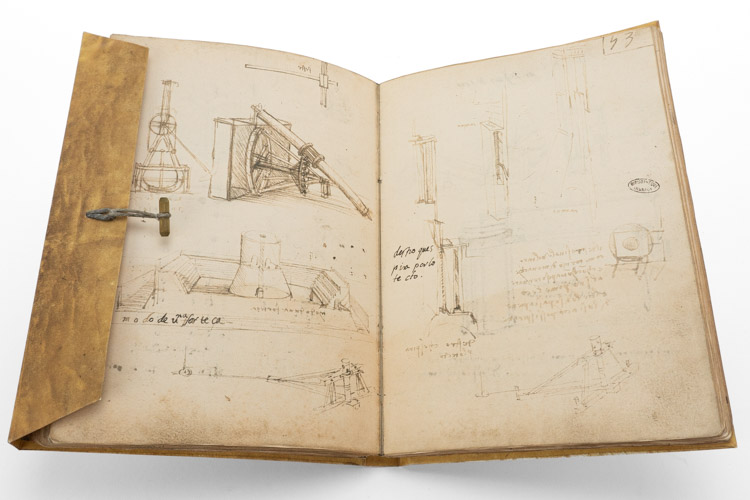
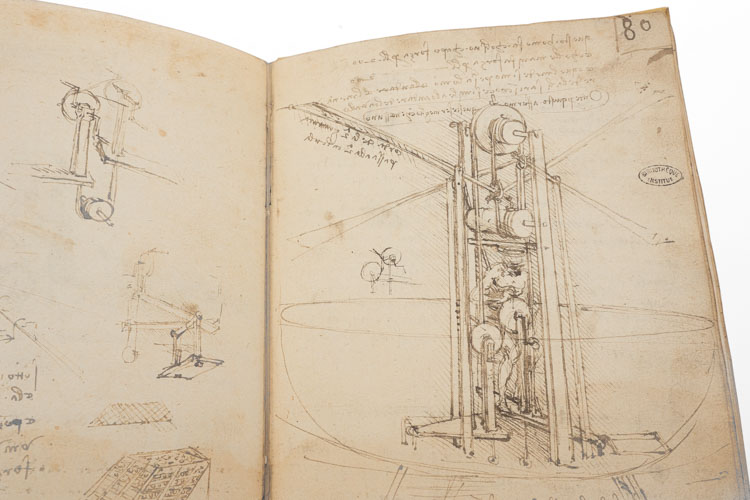
Suppl. A and Suppl. B
Both volumes consist of single pages that once belonged to Manuscript A and Manuscript B, collected by Guglielmo Libri after 1844. To conceal their origins, he erased Leonardo’s original numbering.
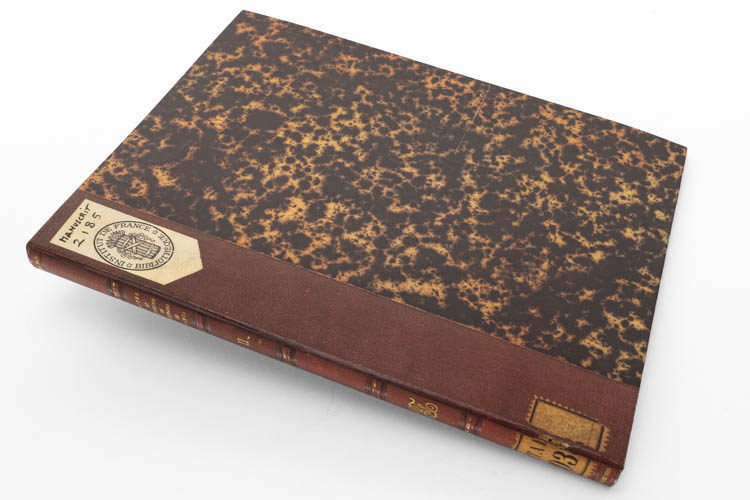
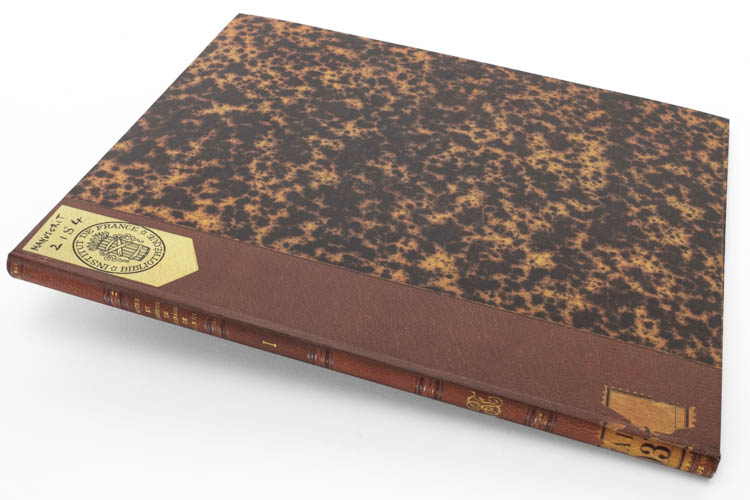
Manuscript C
Composed in 1490-1491, it is dedicated to “shadow and light,” focusing on the variations of forms depending on their lighting and various optical observations applied to painting. It also includes texts on the study of water and percussion.
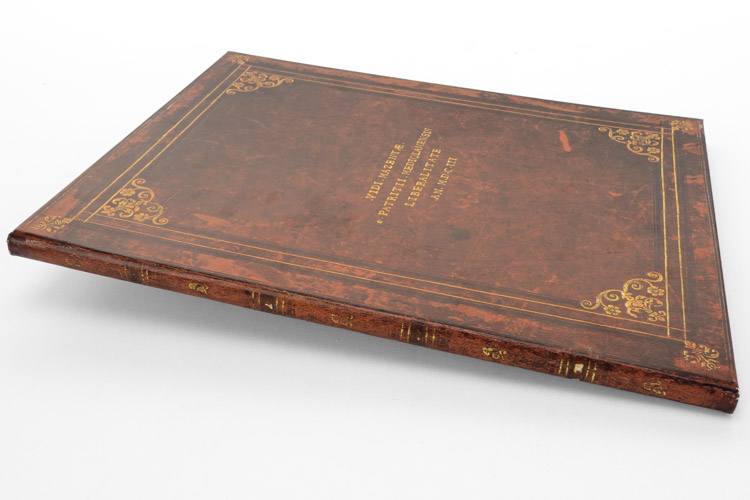
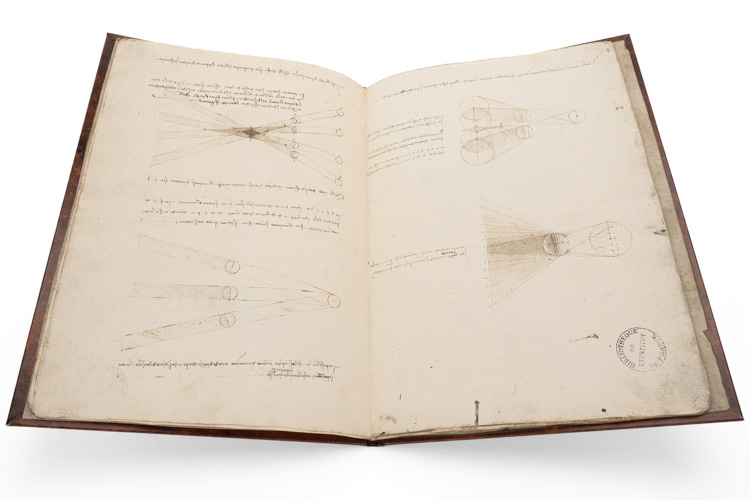
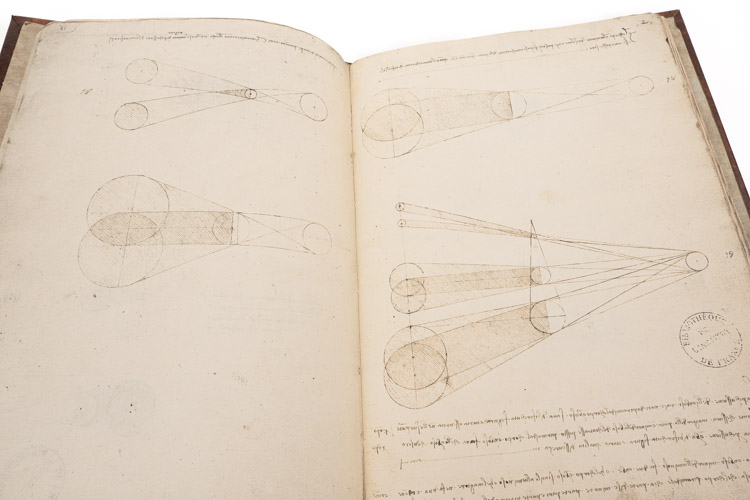
Manuscript D
Written in 1508-1509, it focuses on the study of the eye and the science of vision, drawing on both ancient authors (Avicenna) and Leonardo’s own experiences.
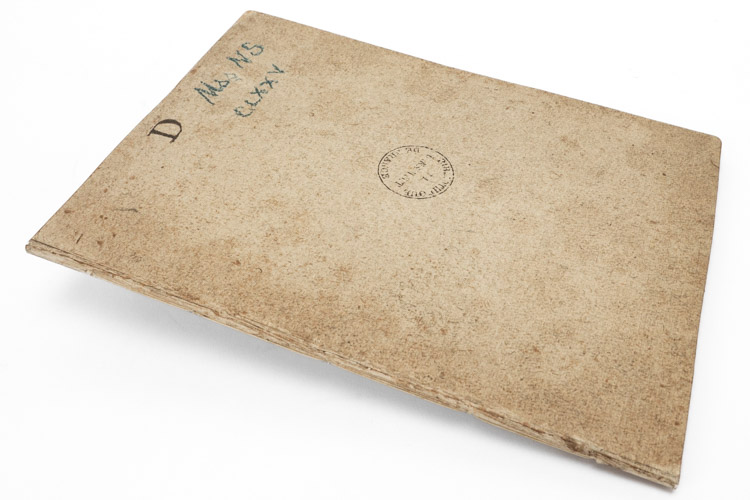
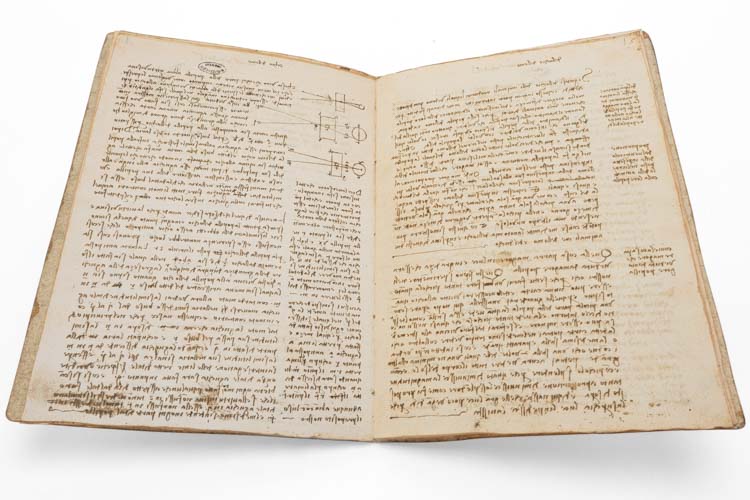
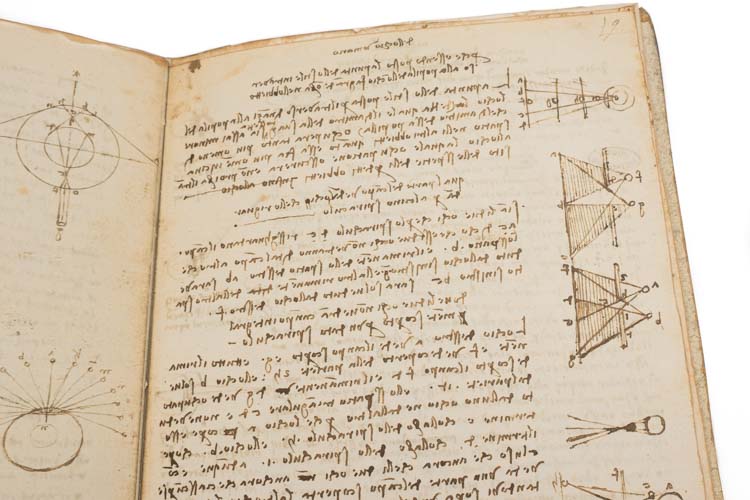
Manuscript E
This work primarily deals with weights but also covers Leonardo’s favorite themes: geometry, painting, motion, technology, and water. It includes studies on natural elements, hydraulics, bird flight, physics, and mechanics, dating to around 1513-1514
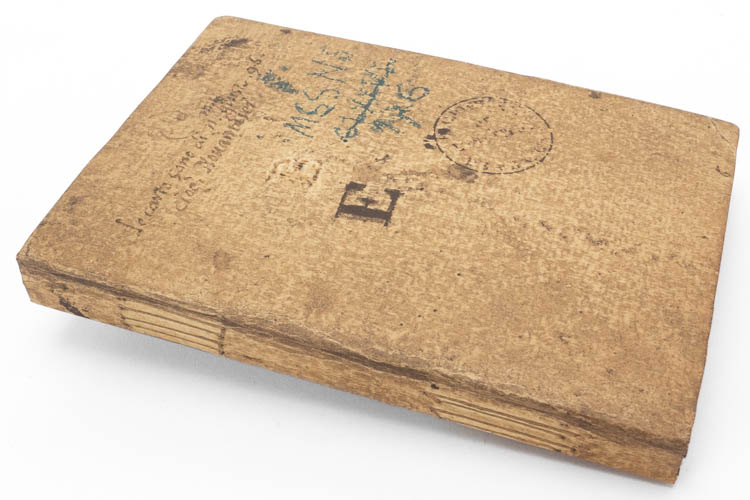
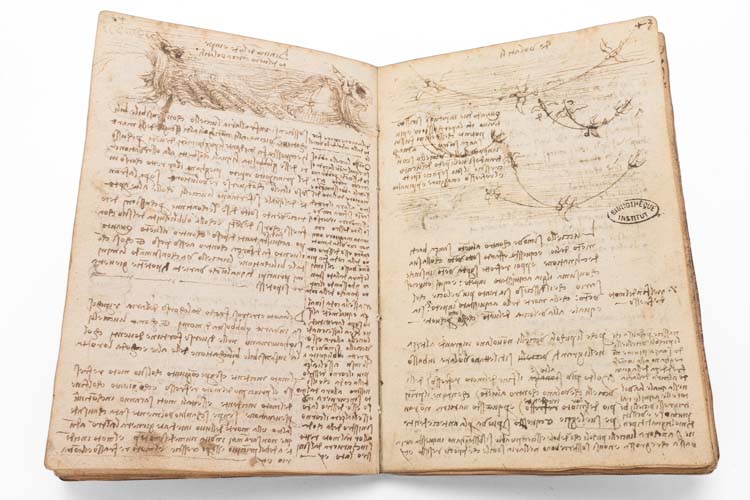
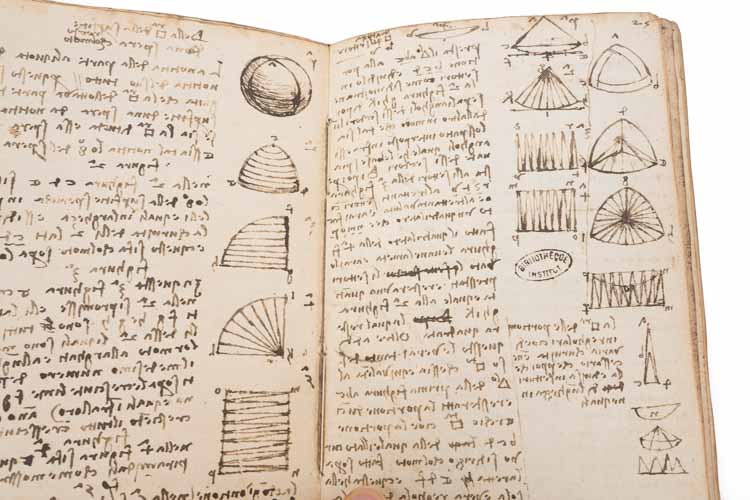
Manuscript F
This work addresses various topics such as water, its movements and management, hydraulic pumps, and themes in optics and geometry. Additionally, it includes studies on natural phenomena like meteorology, cosmology, and geology, dating to around 1508.
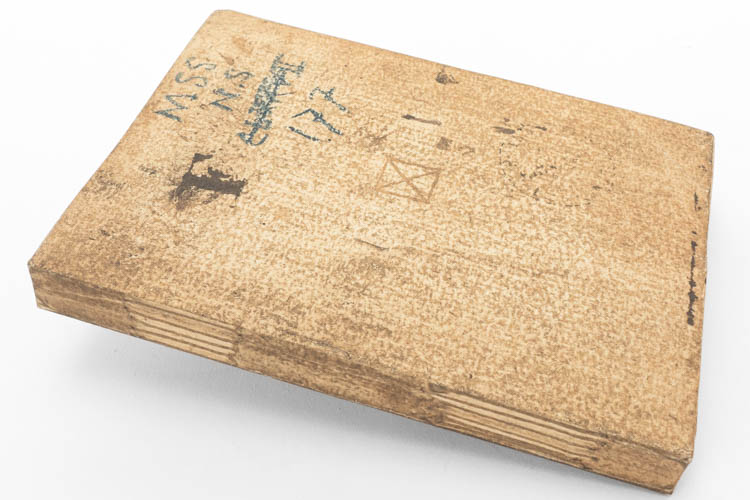
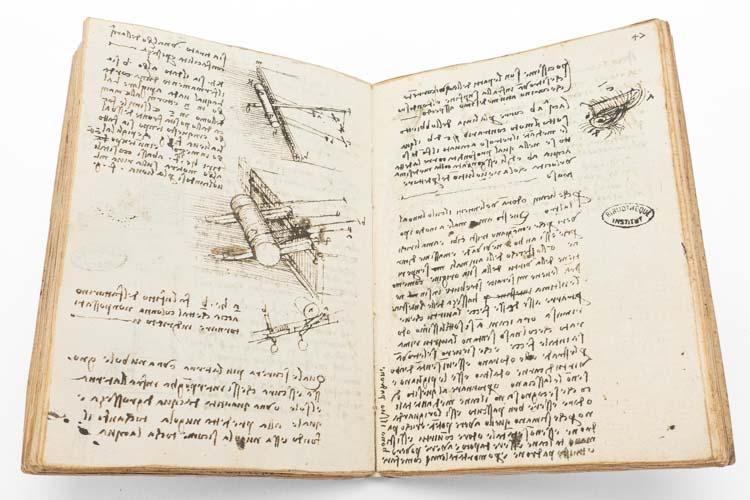
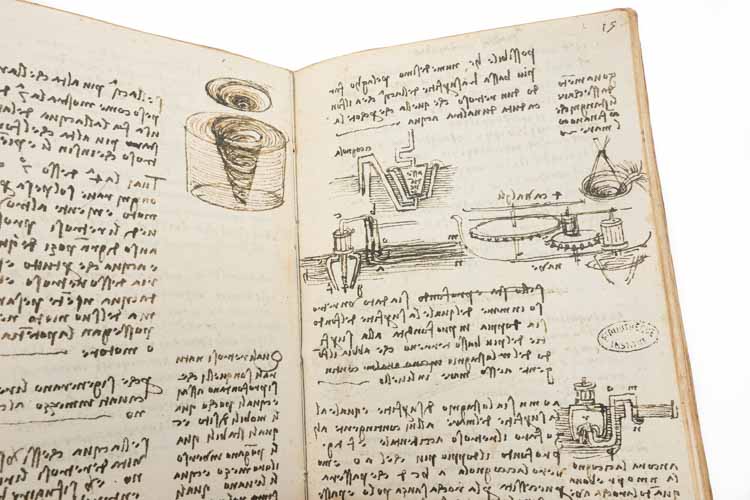
Manuscript G
The first half contains a collection of red chalk drawings and notes on plants and their growth, while the second half covers geometry, bird flight, technology, water, optics, and motion, dating from 1510 to 1515.
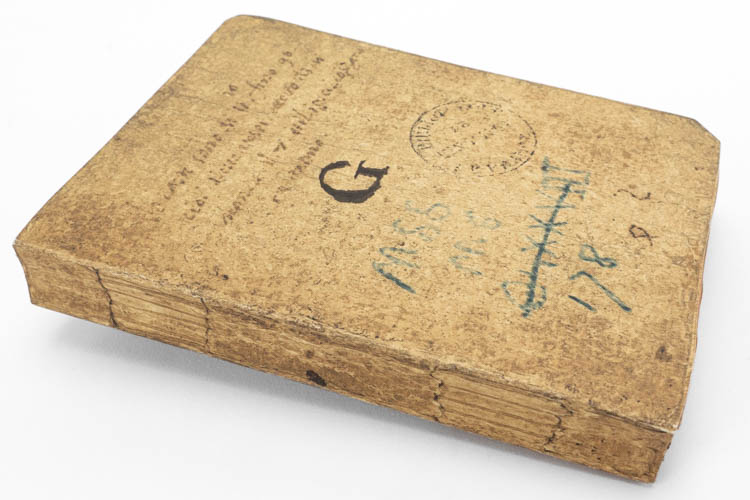
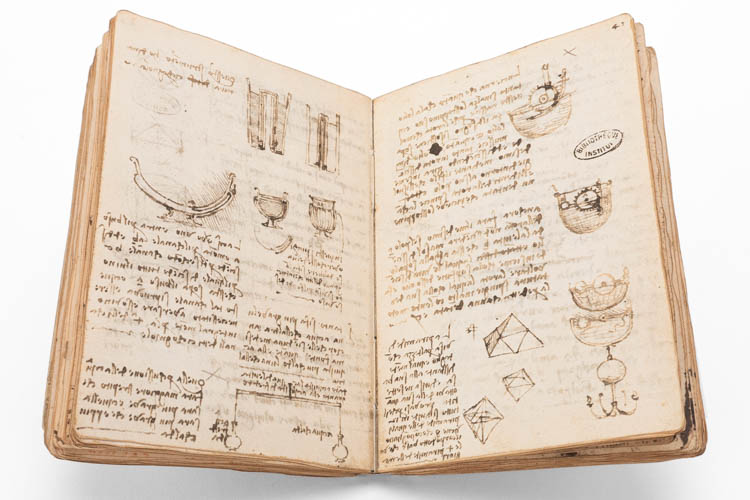
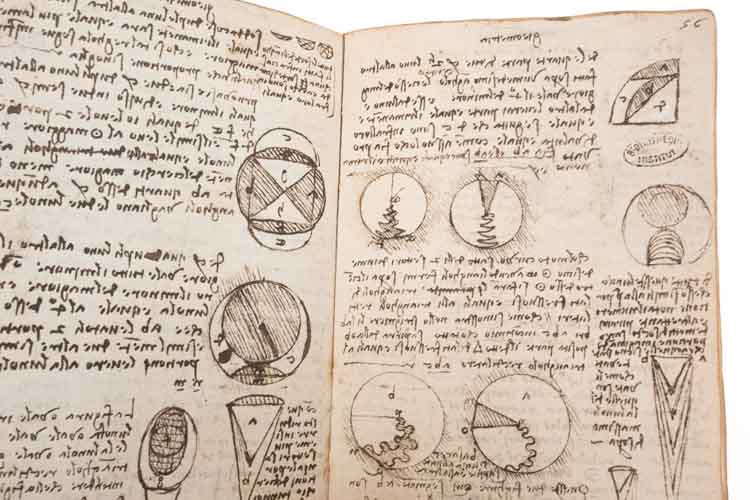
Manuscript H
Comprising a bestiary, proverbs, notes, and drawings for emblems and allegories, hydraulic and mechanical notes, as well as grammatical annotations, this collection dates back to circa 1493-1494. Originally three separate notebooks, water emerges as the dominant theme, particularly its force and the violence of currents. Additionally, the Latin grammar notes reflect Leonardo’s endeavor to study Latin, even at over forty years old, in order to access scientific works.
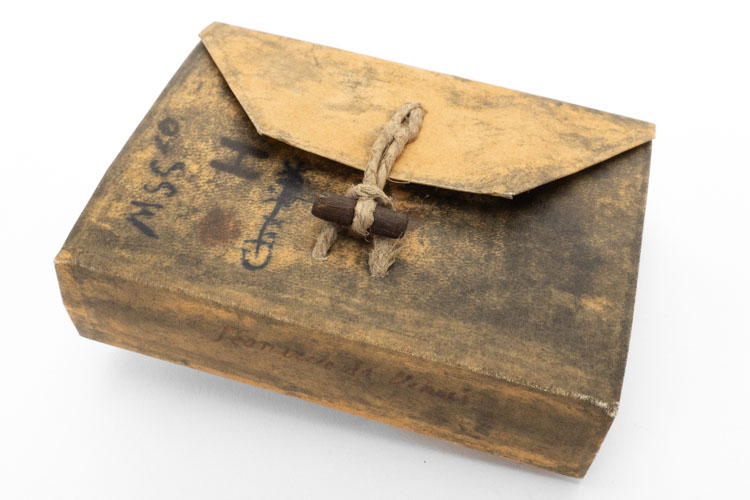
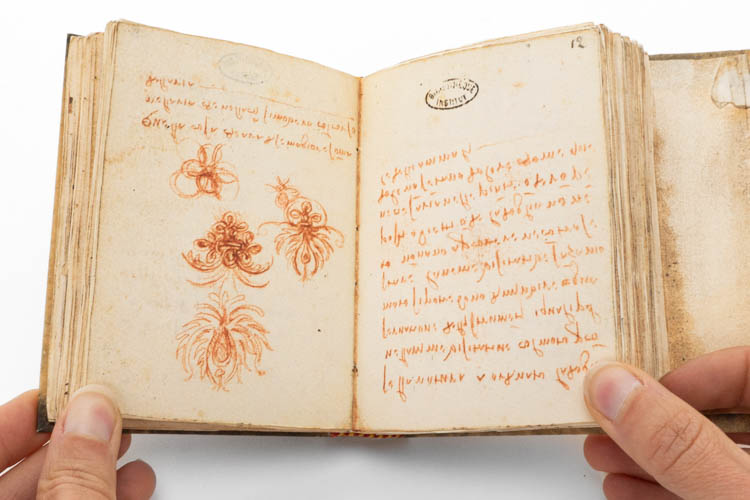
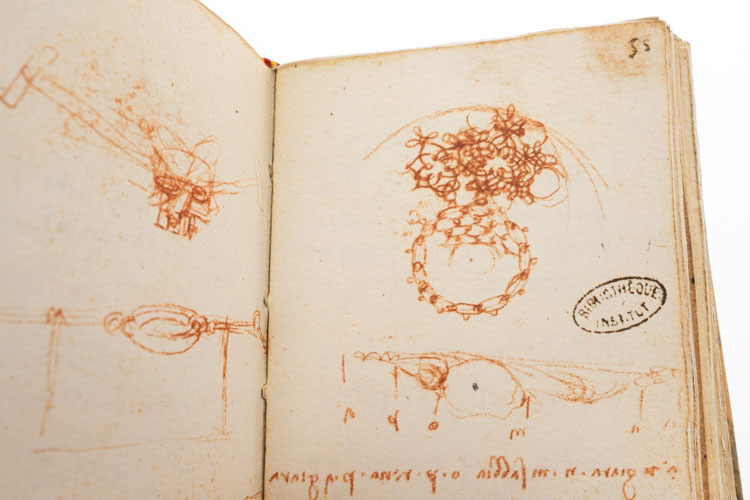
Manuscript I
Texts from Euclid, grammatical notes, writings on water and motion, and prophecies (circa 1497-1499). Originally two separate notebooks, it covers themes of water and mechanics, Euclidean geometry, and various studies in red chalk.
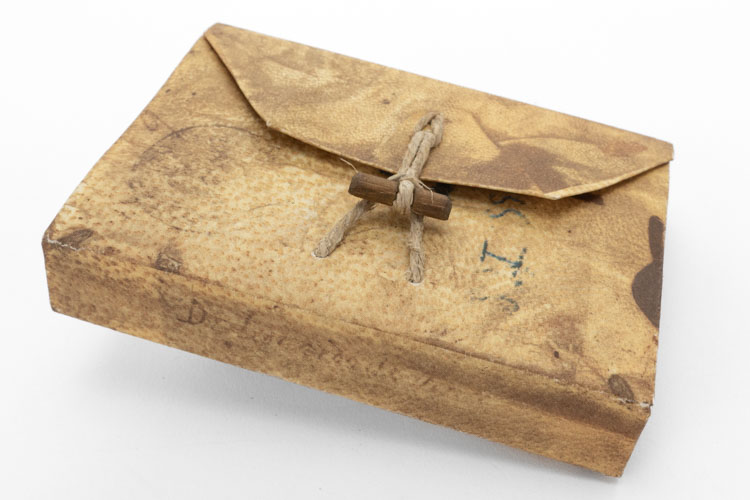
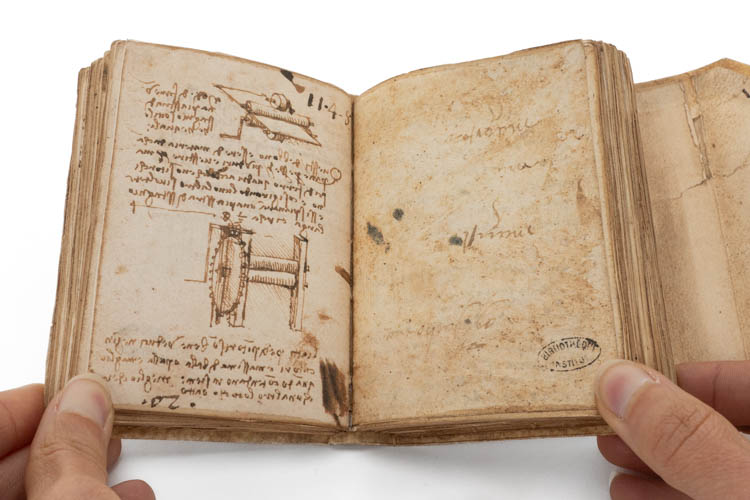
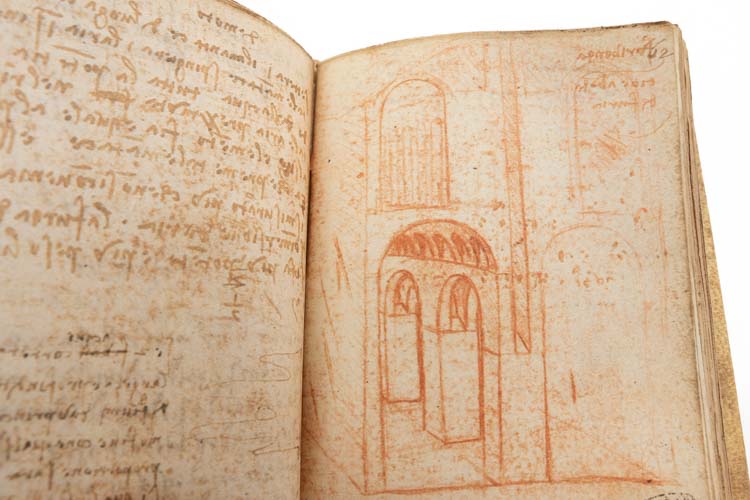
Manuscript K
Contains studies in geometry, anatomy, water channeling, and architecture, with references to the period when Leonardo worked for Charles d’Amboise, the French governor of Milan. Dating back to circa 1503-1507, it originally consisted of three separate notebooks.
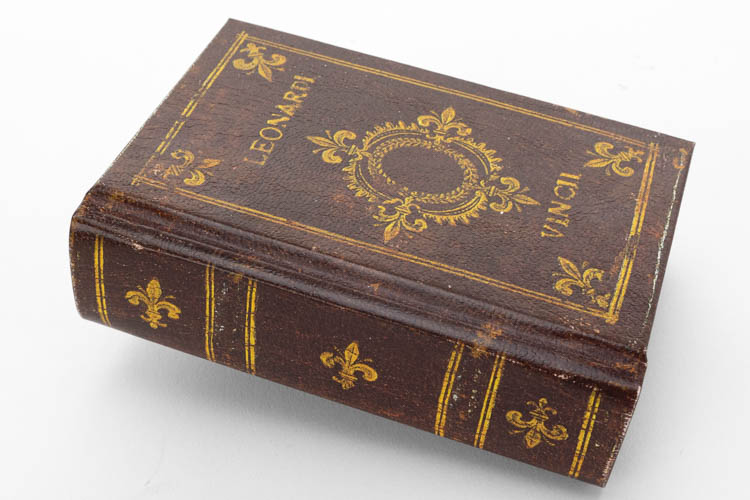
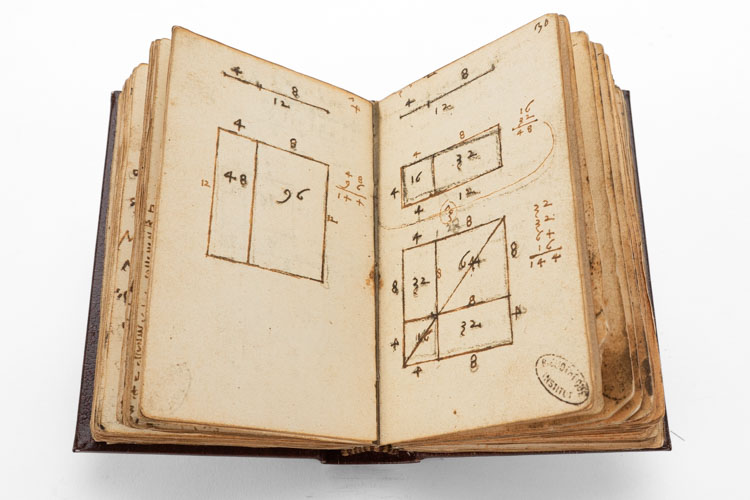
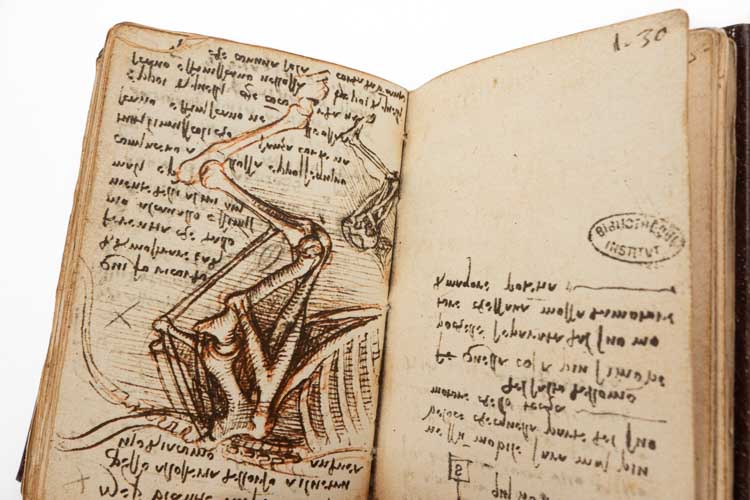
Manuscript L
Contains sketches of fortifications and military architecture dating from 1502, when Leonardo served Cesare Borgia as “architect and general engineer,” and from 1504.
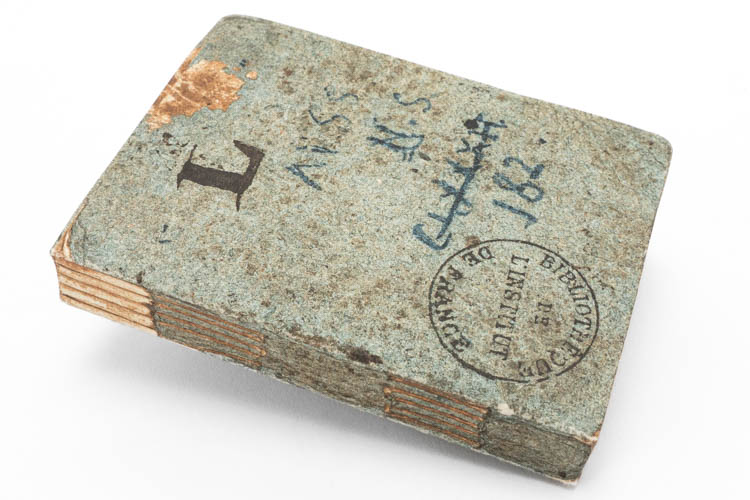
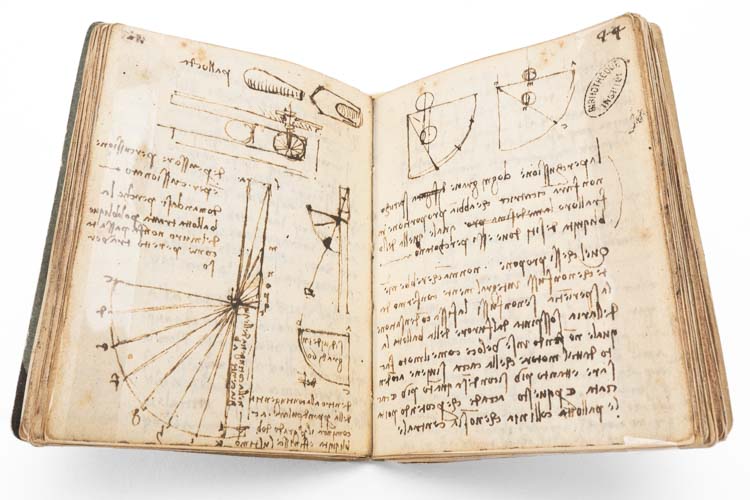
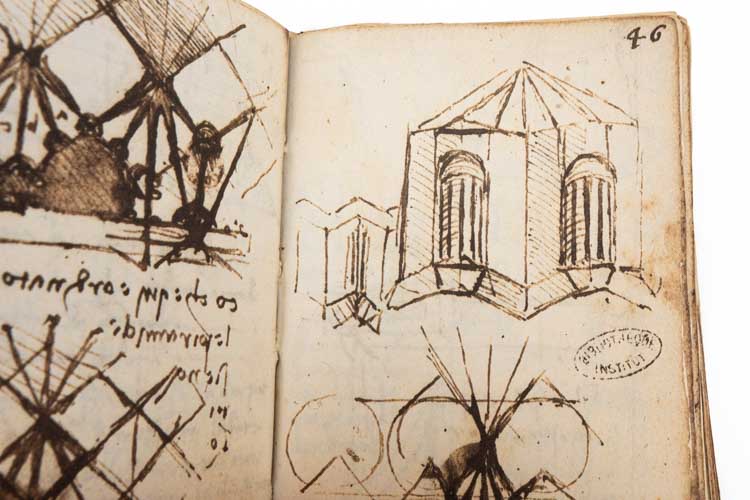
Manuscript M
Dating back to circa 1498–1499, it is dedicated to geometry and physics but also includes notes on botany, emblem drawings, and bridge studies.
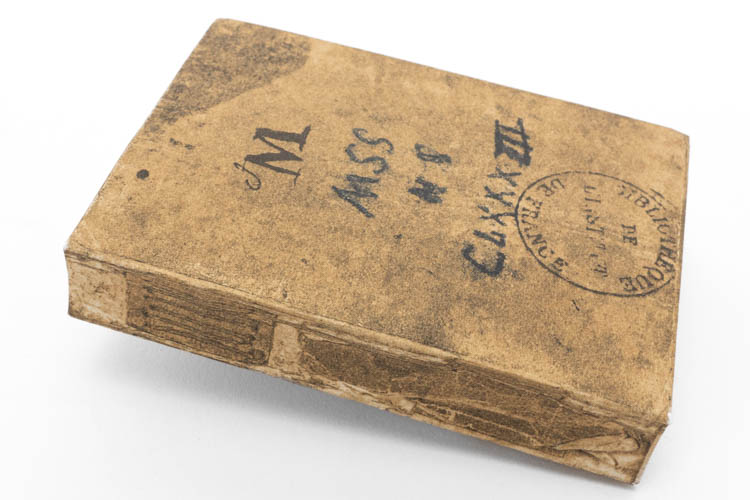
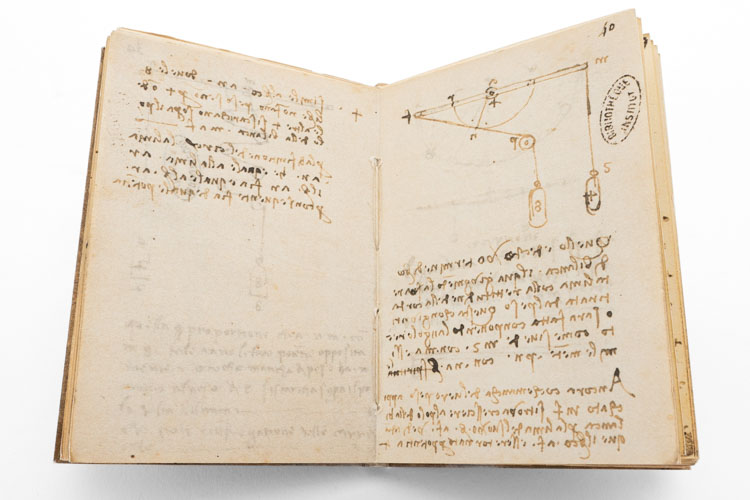
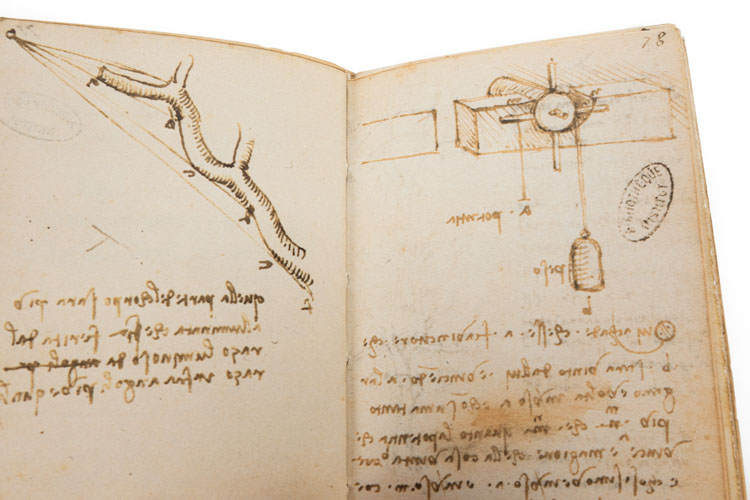
Below are detailed descriptions of each notebook. Scroll down to uncover the fascinating Fun Facts about the newly released facsimile edition
Manuscript A
(cc. 1-64 + 81-114, mm. 212 x 147) Manuscript A was initially part of Pompeo Leoni’s collection, a Milanese sculptor who retrieved a significant number of Leonardo da Vinci’s writings and drawings from Giovanni Melzi, Leonardo’s disciple and designated heir. Later, the pocket notebook became part of Count Galeazzo Arconati’s collection, who donated it to the Biblioteca Ambrosiana in 1637. In 1797, Napoleon ordered its transfer from Milan to Paris.
Originally composed of 114 pages and covered with parchment paper. By the mid-20th century, Manuscript A had been mutilated, losing its last quires, reducing the number of remaining sheets to 63.
The manuscript contains drawings and texts by Leonardo. The autographic numbering proceeds from the beginning to the end, and not vice versa as in other cases. Leonardo’s custom of starting the writing of a book from the end and moving towards the beginning is well known. This is not the case with Manuscript A.
The content of Manuscript A reflects the wide range of Leonardo’s interests, spanning from painting to mechanics, from physics to geometry, and offers a unique look at his theoretical reflections and practical experiments.
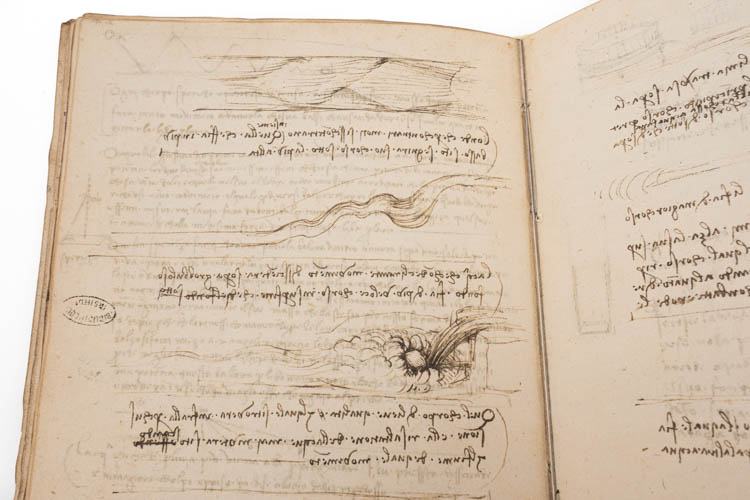
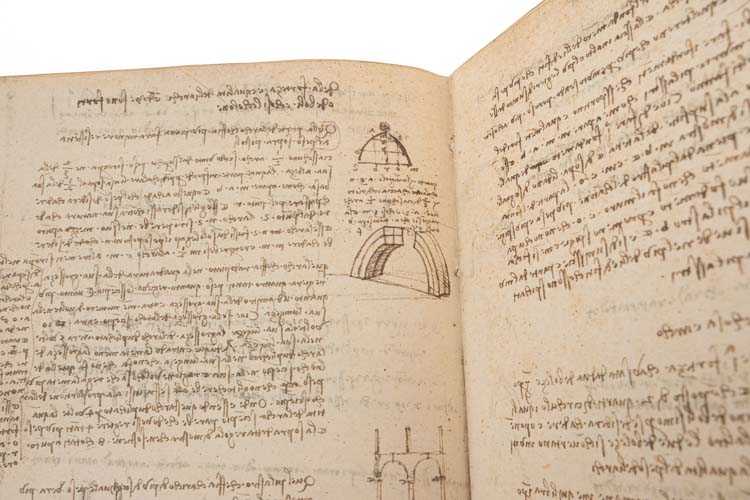
The manuscript provides valuable information on Leonardo’s painting techniques, including his reflections on perspective, the use of shadows and light, and human proportions. His ongoing research on the representation of movement and life through art is evident in the emphasis on dynamism and the vivacity of the act, as well as on grace and fluidity of movement.
Leonardo’s observations on physics, particularly on mechanics and hydrodynamics, reflect his experimental approach and his relentless search to understand the principles that govern the natural world. The manuscript also includes the analysis of motion and forces, as well as Leonardo’s investigations into the behavior of water.
Despite the importance of its contents, Manuscript A also reveals the challenges Leonardo faced in organizing his ideas into a coherent and systematic form. The fragmentary structure and occasional lack of cohesion in his writings reflect both the breadth of his interests and the experimental nature of his working method.
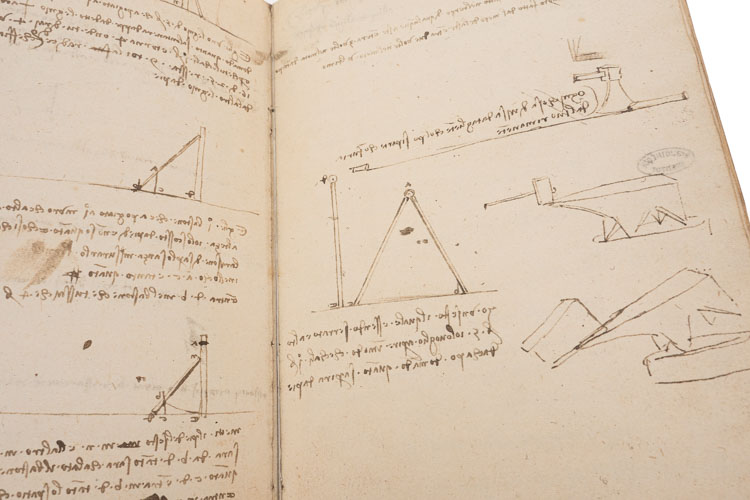
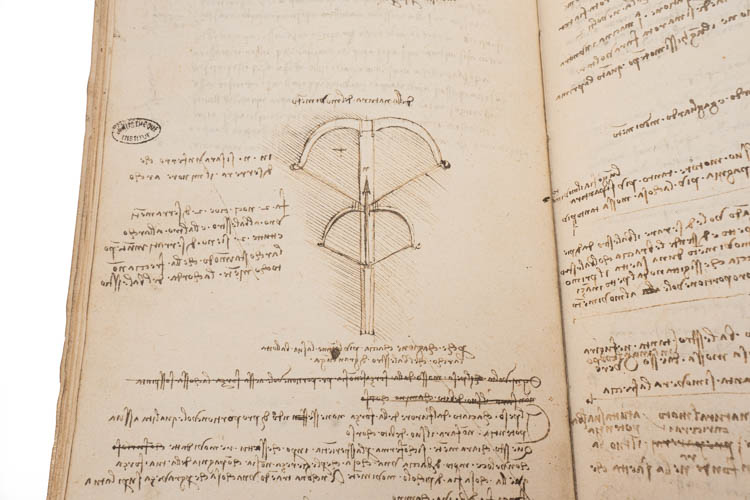
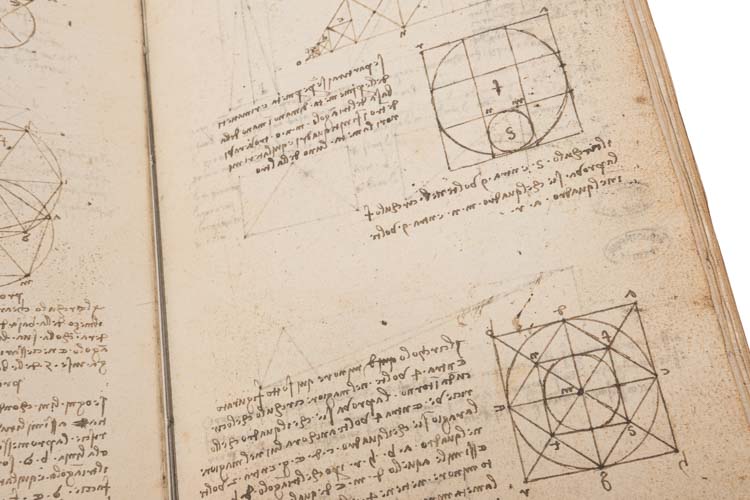
Manuscript B
(cc. 84 + pp. 26, mm. 231 x 167) Composed in the middle of his life, Manuscript B is the oldest among the surviving manuscripts of Leonardo, distinguishing itself with a type of writing and initial script different from his later works.
According to Gerolamo Calvi, who analyzed the manuscript, Leonardo’s script before Manuscript B was characterized by “redundancy and flourishing of strokes,” which transforms into a more expedited and succinct style in subsequent works.
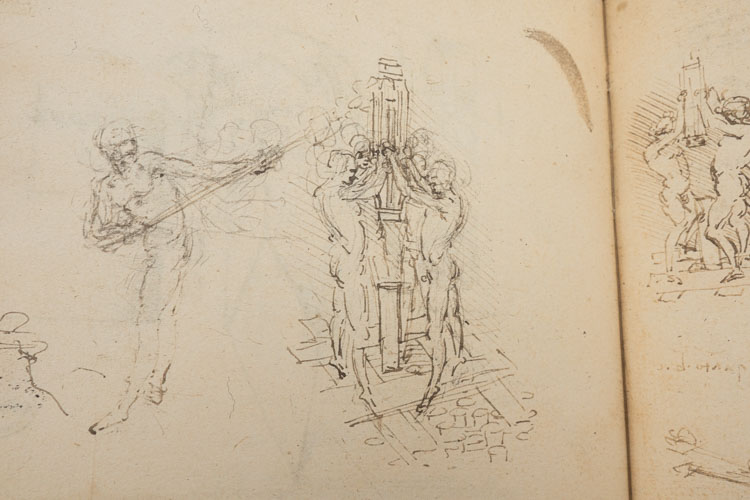
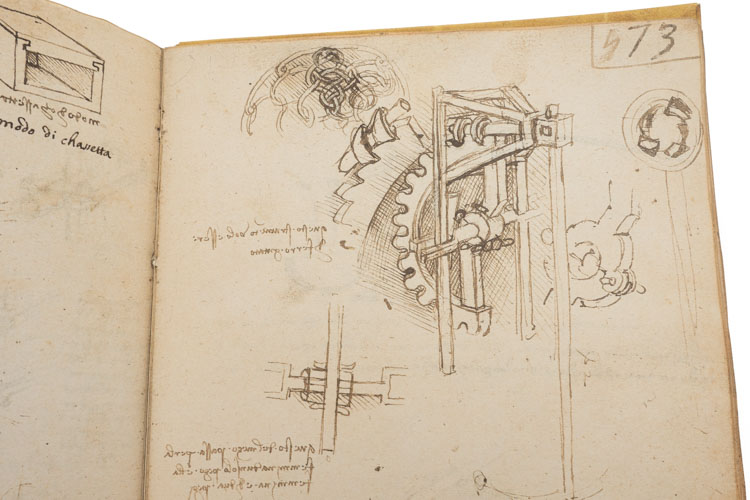
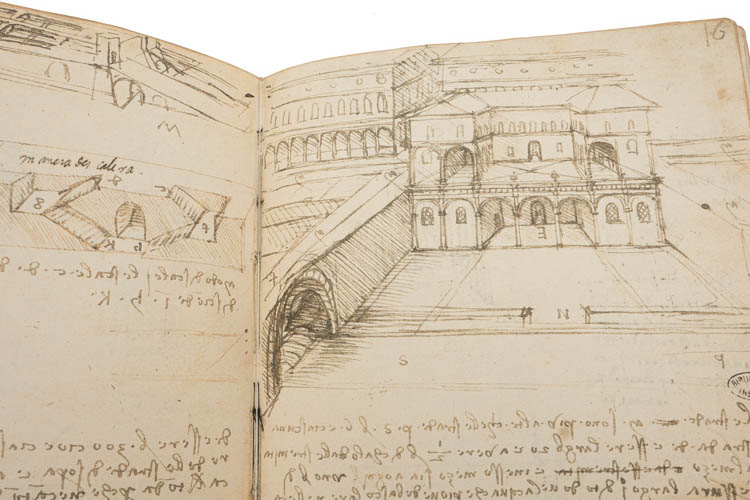
Leonardo defines himself as “omo sanza lettere” (a man without letters), reflecting his self-taught education despite an initial refusal of formal education. This aspect emerges from his practical and experimental approach to knowledge. Leonardo’s decision to write reflects his desire to rise above the consideration of painting as mere mechanical art, emphasizing the scientific and theoretical value of his work. Manuscript B shows how Leonardo drew from various sources to enrich his knowledge, even though his education in some liberal disciplines was still limited by the midpoint of his life.
The manuscript touches on various topics, from mathematics to perspective, from war machines to flight projects, reflecting Leonardo’s wide range of interests and his incessant curiosity. Leonardo advances the radical idea that painting is a science, based on a “mental discourse” that is theoretical and scientifically demonstrable, laying the groundwork for greater recognition of the dignity of art.
The manuscript reveals a Leonardo who adopts a critical stance towards his contemporaries and authoritative in the defense of painting, understood as a discipline that requires scientific and theoretical knowledge.
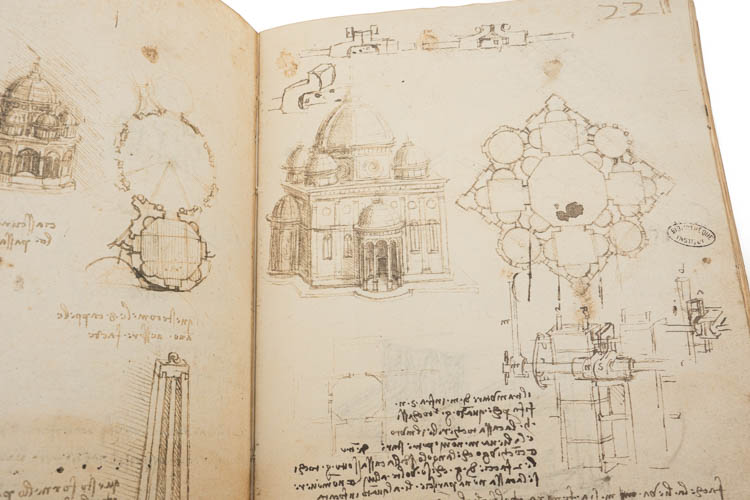
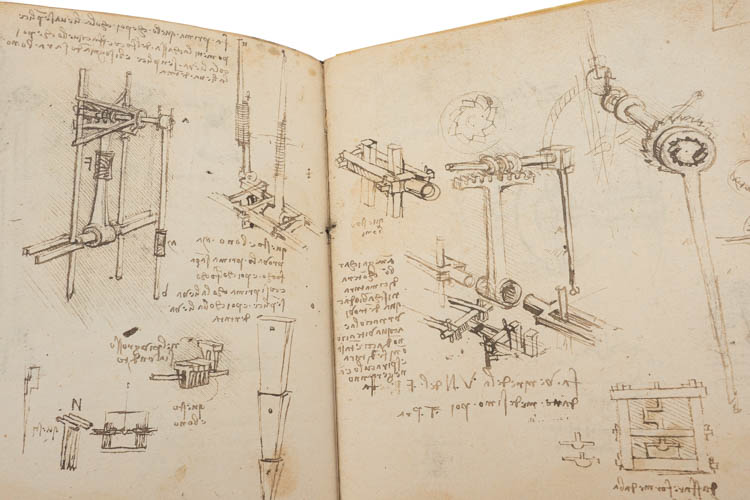
Supplement A and Supplement B
Between 1841 and 1844, Count Guglielmo Libri, who had sought refuge in France and become a naturalized French citizen, conducted official inspections of various French libraries, due to the aftermath of Napoleon’s transfer of works of art. Accused of stealing manuscripts, he fled to England with a substantial haul, including parts of the notebooks A, B, and E from the Institut de France. Some of this material was lost.
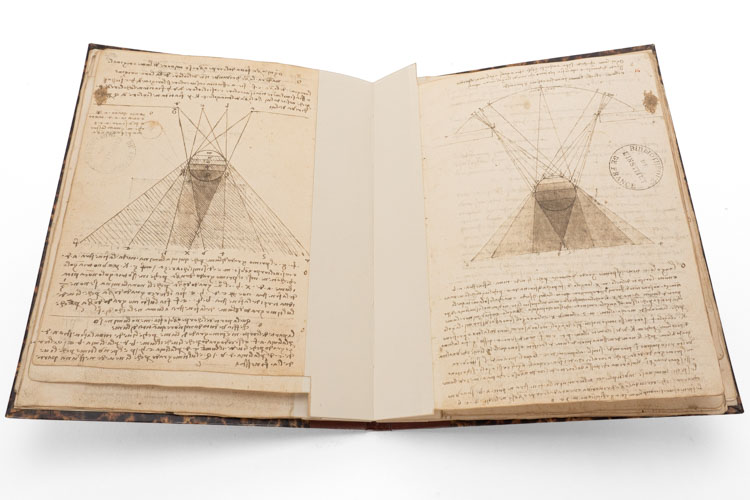
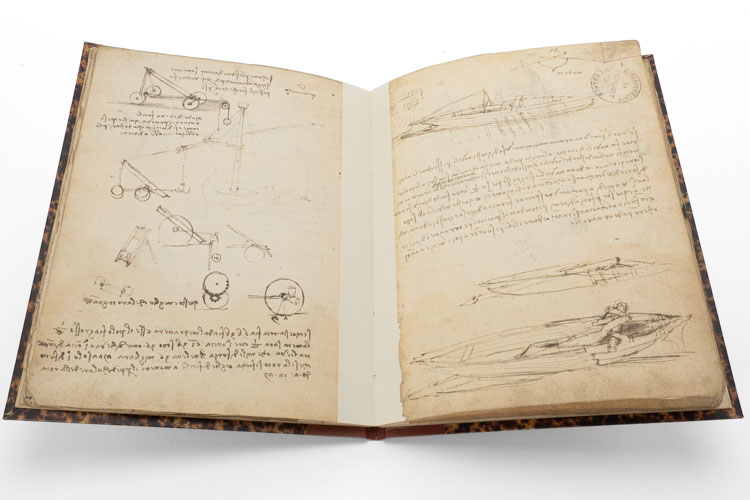
Using the last 34 pages of Notebook A, obtained by cutting 17 bifolios in half, Libri created a volume where each page was placed inside a paper bracket and then sewn into the binding. The title page reads “Notes & Dessins de Leonard de Vinci,” featuring his signature and the date 1875. To conceal their origins, he erased Leonardo’s original numbering. He treated the remains of Notebook B similarly.


Both volumes were sold and became part of Lord Ashburnham’s library, cataloged as 1875/2 for A and 1875/1 for B. After lengthy negotiations, the volumes were returned to France and placed in the National Library with the shelfmarks Italien 2038 (A) and 2037 (B). They were eventually returned to the Institut de France, receiving the shelfmarks 2185 and 2184.
Manuscript C
(cc. 11 + 30, mm. 310 x 222) Manuscript C is in folio format and bound in leather, containing sixteen bifolios folded into thirty-two pages. The cover plates are decorated in gold, with ornamental designs at the corners and inscriptions at the center of the first plate.
The numbering of the pages varies, with the first two pages followed by numbers from 1 to 30. Differences in numbering indicate alterations in the page order after Leonardo’s death.
It features precise writing and drawings mainly made with instruments like rulers and compasses, reflecting special care given to the graphic aspect. Despite the attention to form, the manuscript reflects Leonardo’s tendency towards fragmented composition without a solid narrative thread, typical of his approach to recording observations.
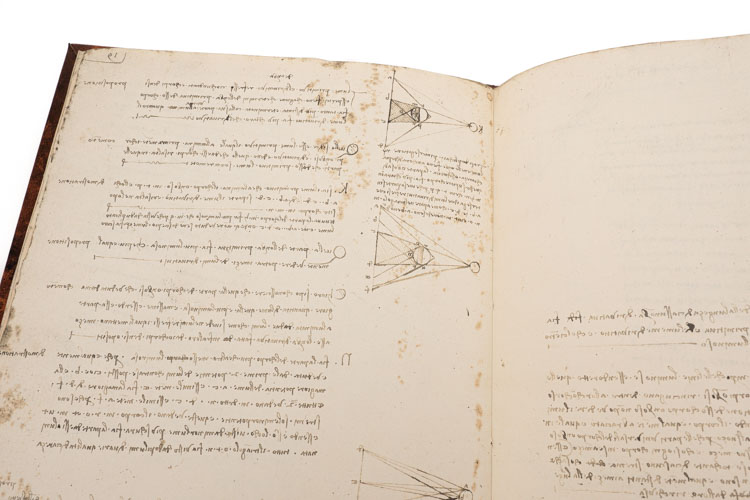
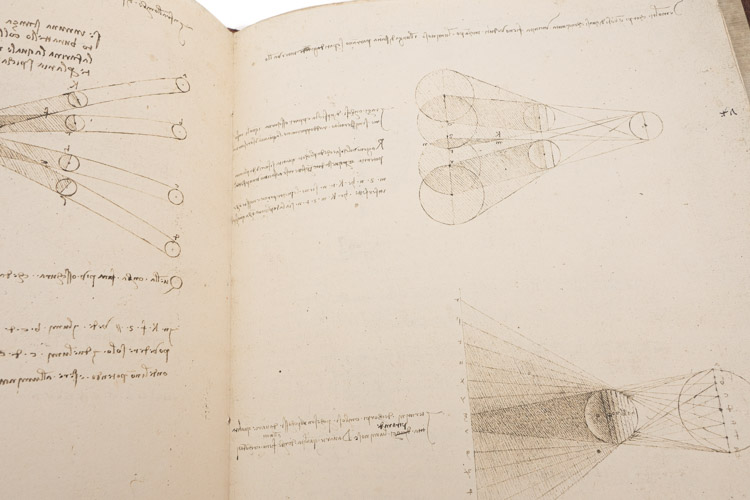
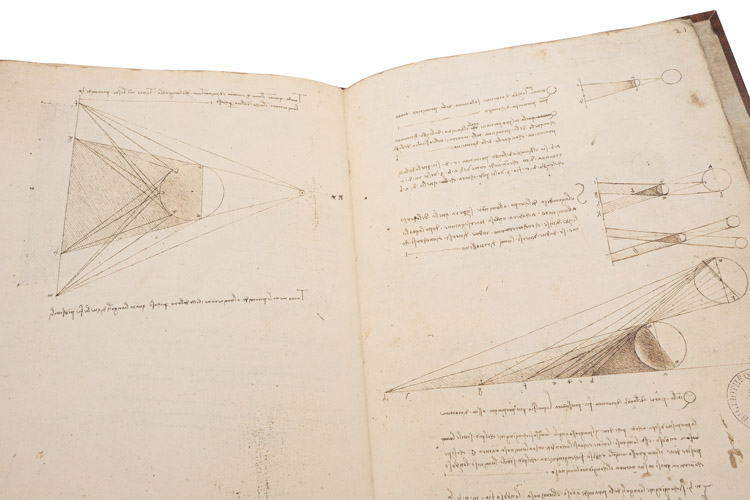
The manuscript primarily discusses light and shadow from a scientific perspective, with insights into mechanics, hydraulics, and perspective. Despite the scientific approach, it has traditionally been considered an aid for painters, closely linked to optical science.
Next to many drawings of shadows and lights are alphabetical signatures from another hand, used to organize and reference the drawings to their corresponding texts. Analysis of the numbering and signatures reveals that the manuscript was reorganized after Leonardo’s death, combining sheets that were initially separated into different fascicles.
Manuscript C has a unique ownership and transfer history compared to other Leonardo manuscripts, having avoided dispersion by Pompeo Leoni and ending up in the Ambrosiana Library before its transfer to the Institut de France.
Manuscript D
(cc.10, mm. 220 x 158) Manuscript D consists of a notebook made from five bifolios stitched inside a grey cardboard cover.
The text is written in a very regular, compact script with almost no cancellations, suggesting it is a fair copy. The number of lines varies from thirty-eight to forty-nine per page, except the first page which is only partially written.
About one-third of the width on the right side of each page is reserved for diagrams and brief annotations related to the study of the eye’s anatomy and the path of light, with three pages entirely dedicated to annotations without diagrams.
The manuscript contains 61 or 63 diagrams (as identified by Corbeau), mainly schematic, focusing on the anatomy of the eye and the path of light within it. The content also explores the anatomy of the eye and the physics of light and vision, diverging from traditional descriptions and proposing new hypotheses. Indeed, the manuscript manuscript showcases Leonardo’s exploration of optical terms and concepts, with a detailed examination of the eye’s structure and function, using specific terminology and engaging in a complex syntactic structure to argue and demonstrate his points.
There is consensus on dating Manuscript D to around 1508, although Corbeau suggests a period between 1513 and 1516 during Leonardo’s time in Rome, based on the thematic focus on anatomy and optical devices.
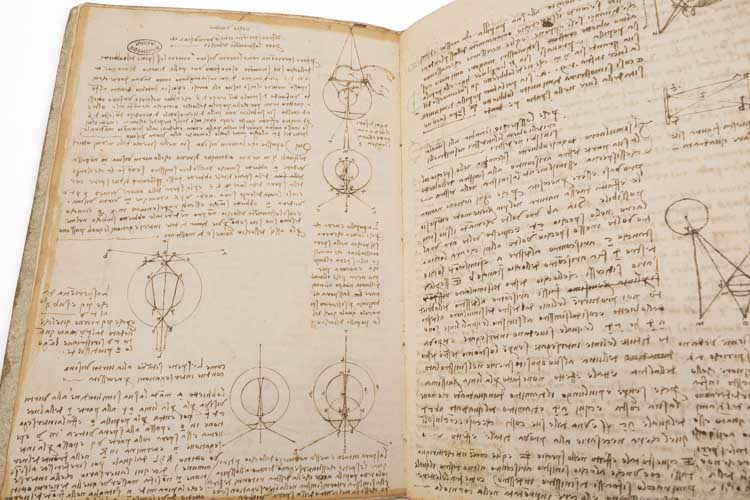
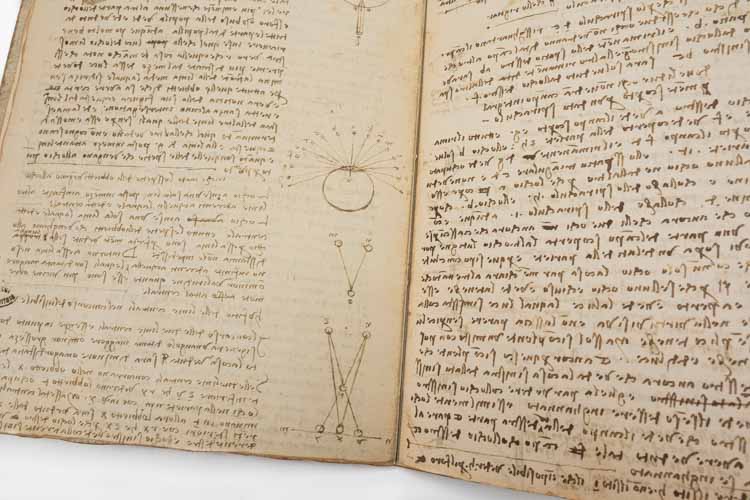
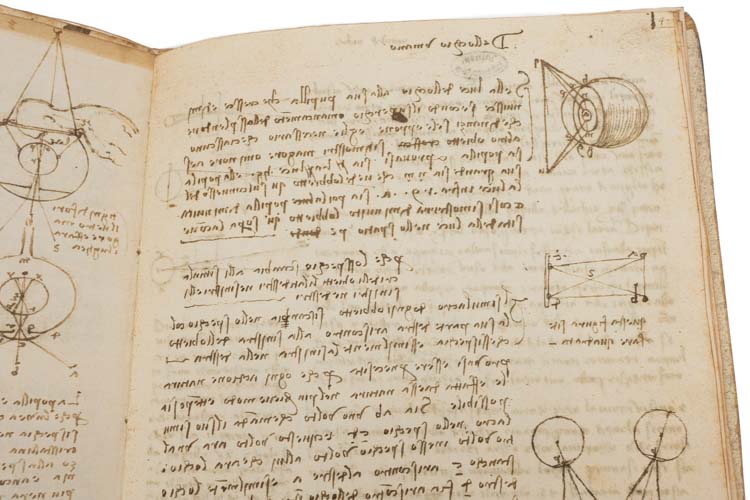
The history of Manuscript D is somewhat unclear, not showing direct ties to Pompeo Leoni or the initial donation to the Biblioteca Ambrosiana. Its presence in the Ambrosiana’s collection is recorded between the donation by the Arconati family (post-1637) and before 1674, with its eventual transfer to Paris in 1796 and subsequent scholarly attention and publication.
Manuscript E
(cc. 96, mm. 150 x 105) The manuscript contains dates from September 1513 and 1514, placing its creation towards the end of Leonardo’s life. Originally composed of 96 pages as noted by Melzi, but only 80 remain due to theft, indicating the manuscript was intact until at least 1637, based on the donation act by Count Arconati to the Biblioteca Ambrosiana.
The manuscript deals with a range of subjects from mechanical physics, to geometry, the mechanics of flight, and properties of water, showcasing Leonardo’s interdisciplinary approach to science and art.
Leonardo’s autograph numbering of pages suggests a normal direction of writing, although there are indications that he did not always follow this in his work, showing a more flexible approach to organization.
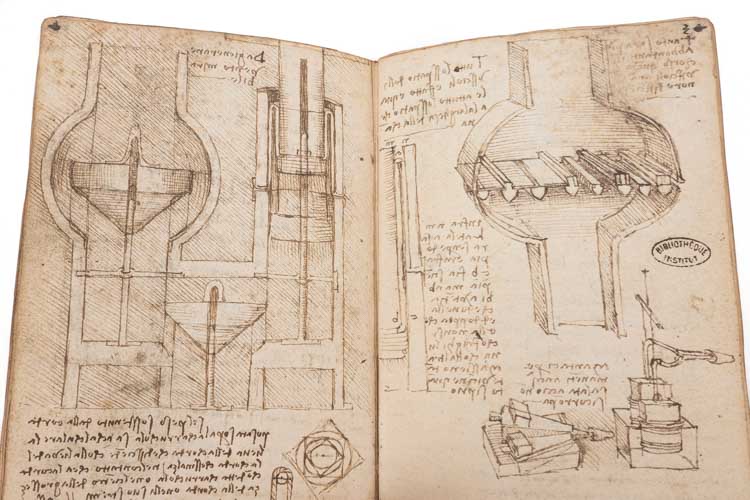
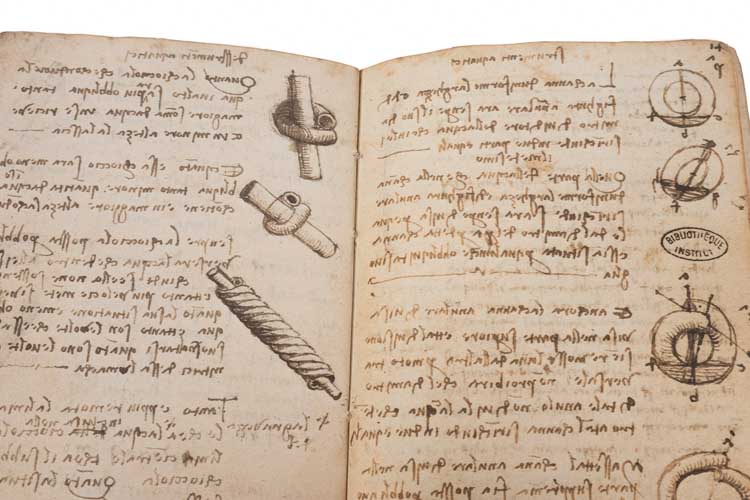
A significant portion is dedicated to mechanical physics, including Leonardo’s law of the composition of concurrent forces, showcasing his contributions to the field of mechanics.
It includes geometric and mathematical exercises, demonstrating Leonardo’s practical approach to mathematics, often for the purpose of application in engineering and art.
Manuscript E also touches upon Leonardo’s theories of painting, perspective, and the representation of motion, reflecting his belief in painting as a science.
Descriptions of various technological innovations, including aquatic instruments and sophisticated devices aiming at continuous motion, illustrate Leonardo’s inventive mind. Leonardo’s critical view on the pursuit of perpetual motion is evident, highlighting his skepticism towards certain “soffistico” (sophistic) endeavors.
The manuscript reflects Leonardo’s engagement with classical scientific texts, albeit translated or paraphrased into the vernacular, indicating his self-education and reliance on contemporary translations.
Manuscript F
(cc. 96, mm. 145 x 100) Manuscript F consists of 96 sheets, distributed in 6 booklets of 8 bifolia each, stitched and enclosed in a cardboard cover. It features autograph writings by Leonardo and autograph numbering of the sheets, indicating a transmission almost intact to Pompeo Leoni.
Begins in Milan on September 12, 1508, as indicated in red pencil and inked over on a sheet, suggesting a time-concentrated work on limited themes. The homogeneity of the content and the absence of blank pages indicate continuous work, possibly without significant interruptions.
Focused primarily on hydraulics, optics, and geometry, distributed in blocks of consecutive pages, reflecting a methodical and concentrated approach.
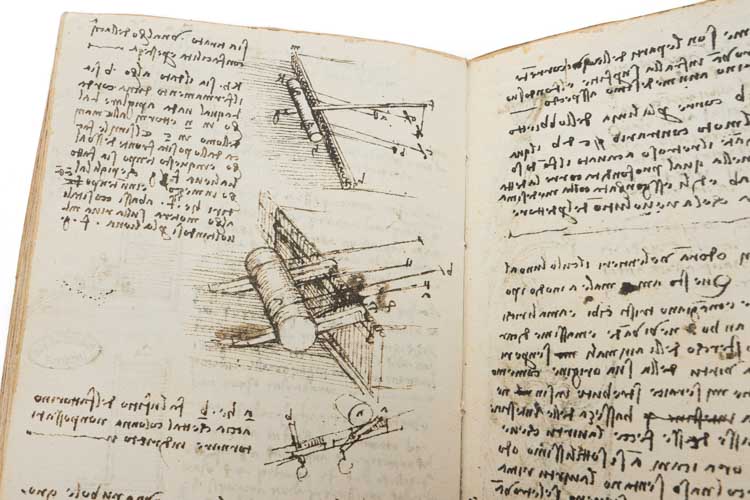
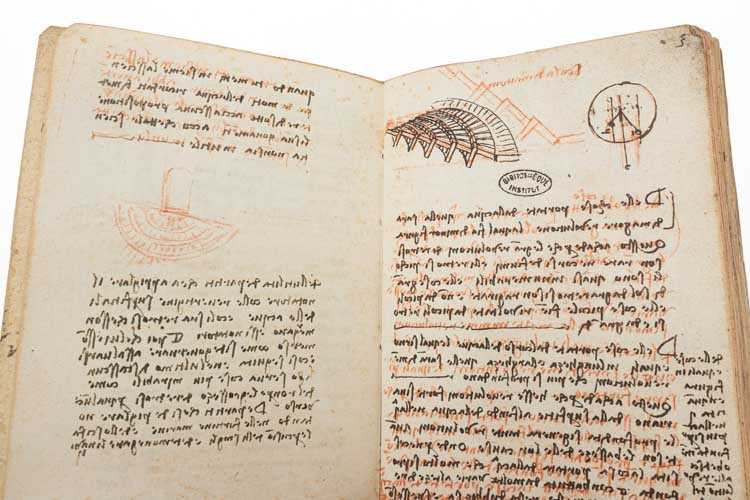
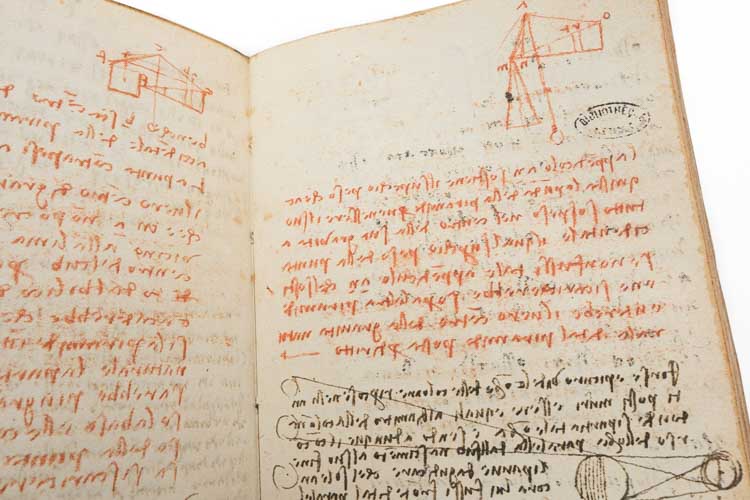
Unlike other manuscripts by Leonardo, the numbering of the pages proceeds from the beginning towards the end, suggesting a linear path in the development of the topics covered. Despite the progressive numbering, Leonardo uses the term “turn the page” to indicate the continuation of the discourse on the next page, demonstrating a flexible organization of the content.
The structure of the manuscript highlights a division into homogeneous thematic blocks, with particular attention to hydraulics and optics, a feature that demonstrates Leonardo’s systematic approach to research.
Contains a note in which Leonardo defends the ancient inventors of “grammars and sciences” from the criticism of contemporaries, indicating an evolution in his appreciation of ancient knowledge and his own role as a scholar and inventor.
The manuscript is rich in self-citations and references to Leonardo’s works, indicating reflection on the organization and publication of his studies.
Addresses the classical problem of doubling the cube, with attempts at resolution that reflect the depth and originality of Leonardo’s mathematical thought.
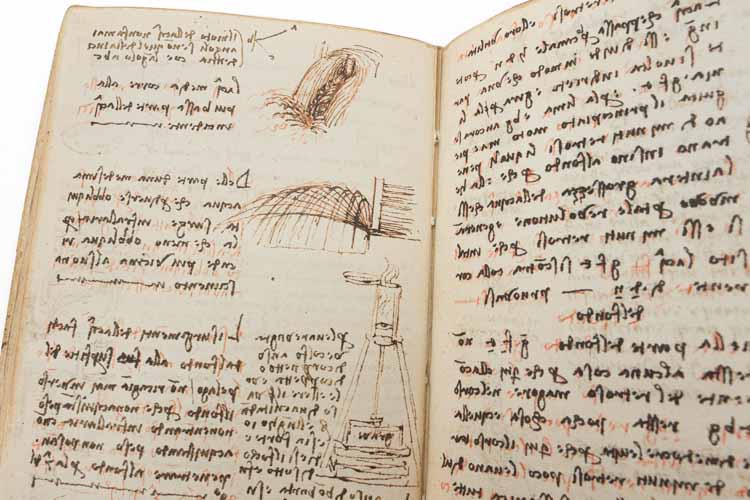
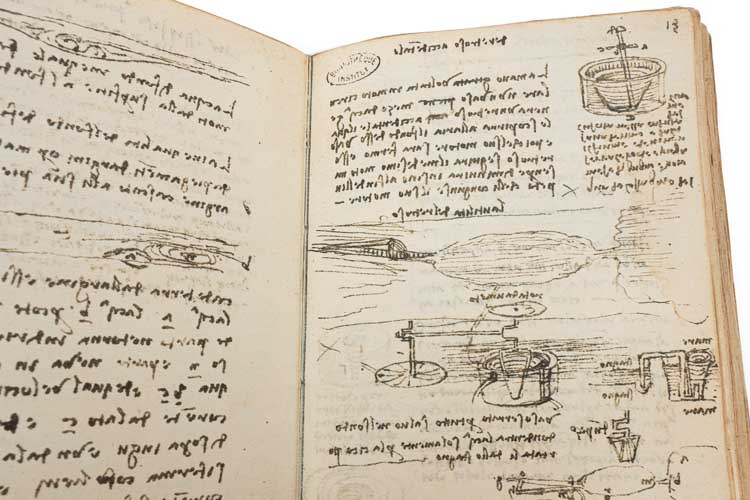
Includes considerations on celestial bodies, such as the sun and moon, and reflections on motion and light, showing the breadth of Leonardo’s scientific interests and his ability to integrate practical observations with abstract theories.
Manuscript G
(cc. 93, mm. 139 x 97) Manuscript G, part of the collection that came into the hands of Pompeo Leoni, is preserved with its original carton cover, indicating the care taken to maintain these works since Leonardo’s time.
The manuscript is identified by a large “G” classified by Venturi, with additional inscriptions by Francesco Melzi and historical markings from its time at the Biblioteca Ambrosiana and during the Napoleonic transfer to Paris.
Contains dates marking significant periods of Leonardo’s life, offering insights into the timing and context of his works within this manuscript.
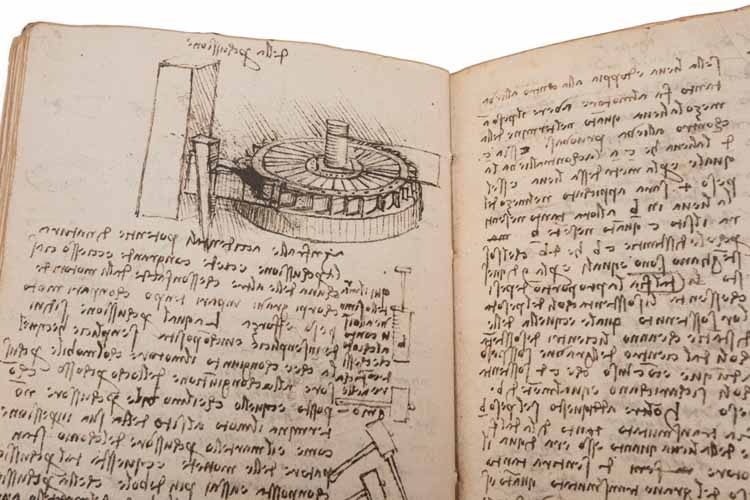
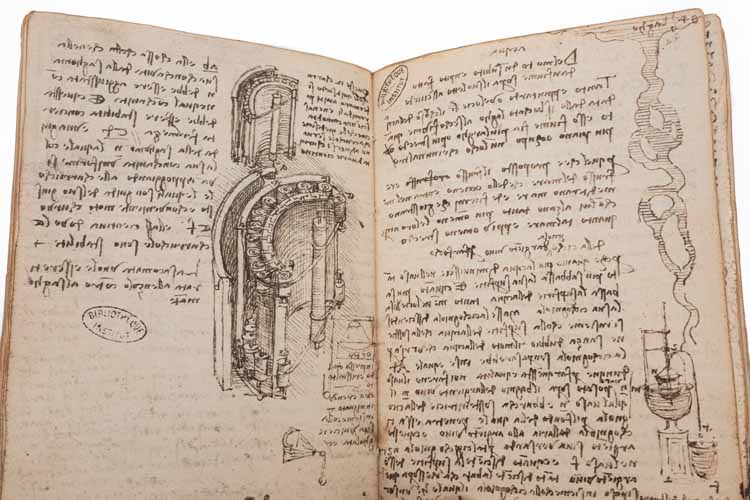
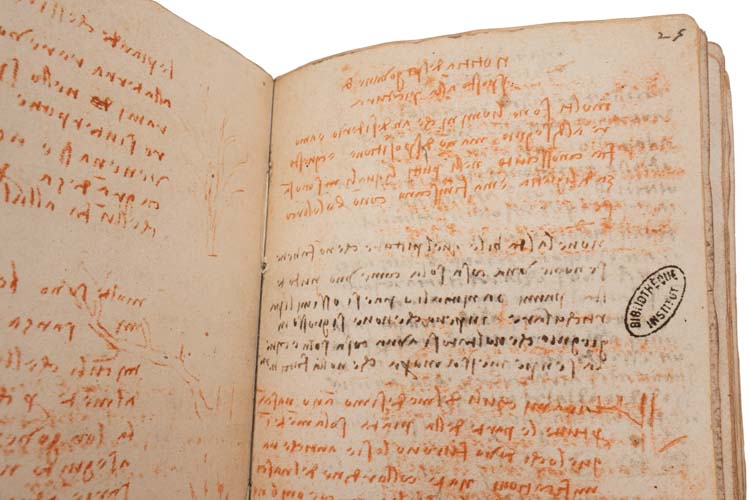
It primarily explores botany and its application to painting, emphasizing the observation of light, shadow, and form in plants, and its relevance to art.
It delves into geometry, the study of light, shadows, reflections, and various scientific and technical explorations, including the study of water, weights, and mechanical devices.
Features Leonardo’s mathematical and geometric considerations, such as the division of circles, the study of plant morphology, and reflections on geometric shapes and volumes.
Contains studies on the motion of elements, including air and water, showcasing Leonardo’s interdisciplinary approach to understanding the natural and mechanical world.
Offers reflections on the unity of science and practice, the certainty of mathematical sciences, and observations on natural laws governing the physical world.
Includes advanced speculations on topics like the rotational motion of the earth and celestial bodies, touching on concepts that resonate with later scientific discoveries.
Reveals Leonardo’s process of integrating scientific observation with artistic practice, illustrating his unique method of learning and creating through direct observation and theoretical speculation.
Manuscript H
(cc. 142, mm. 128 x 90) Manuscript H was created by binding together three smaller Vinci notebooks into a single volume. These notebooks, referred to as “quaderni,” were small in size, similar to what Melzi referred to as “librettini” in Codex Urbinate 1270.
Leonardo often carried these notebooks in his pocket, making rapid, preliminary notes in red or black pencil, which he would later revisit and elaborate upon with ink at home.
The leather wallet-style binding with a closure strap and thong is similar to seven other manuscripts (A, B, I, Trivulziano, and the three Forsters), dating between 1608 and 1637.
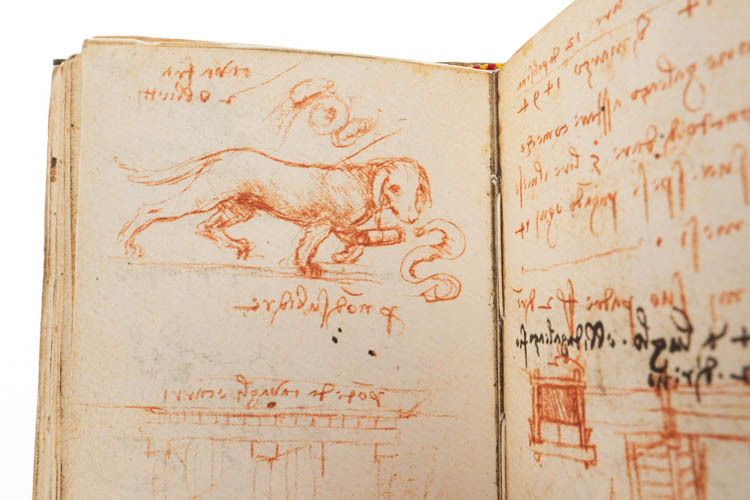
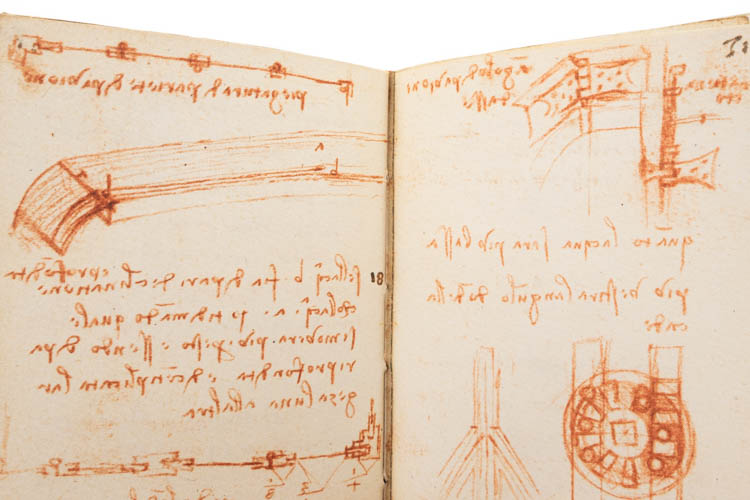
Manuscript H focuses on various subjects including hydraulics, dynamics of water, and contains several engineering designs. Leonardo’s calculations and designs for hydraulic projects, including canals and water management systems highligh his contributions to engineering and practical applications of his scientific knowledge.
The manuscript includes detailed studies on the dynamics of water, mechanics, and also reflections on mathematical problems, showcasing Leonardo’s methodical approach to science and technology.
Specific notes within the manuscript help date certain entries to the years 1493-1494, providing a contextual timeline for Leonardo’s work on these subjects.
Manuscript I
(cc. 129, mm. 100 x 75) Manuscript I consists of two original Leonardo notebooks, both in sixteenth size, highlighting uniformity in size despite slight variations. These notebooks were part of Leonardo’s bequest to his pupil Francesco Melzi, eventually ending up in the hands of Pompeo Leoni, who catalogued them using numbers and letters.
Leoni’s cataloging and rebinding process involved applying sequential numbers to each page within the notebooks and adding unique signatures, reflecting a methodical approach to organizing Leonardo’s works.
After Leoni’s death in 1608, the manuscript, among others, was acquired by Count Arconati, who donated them to the Biblioteca Ambrosiana in 1637, where it was cataloged as part of a collection. In 1796, Napoleon ordered the transfer of Vinci’s manuscripts to Paris, leading to a reclassification of Manuscript I by G. B. Venturi at the Institut de France.
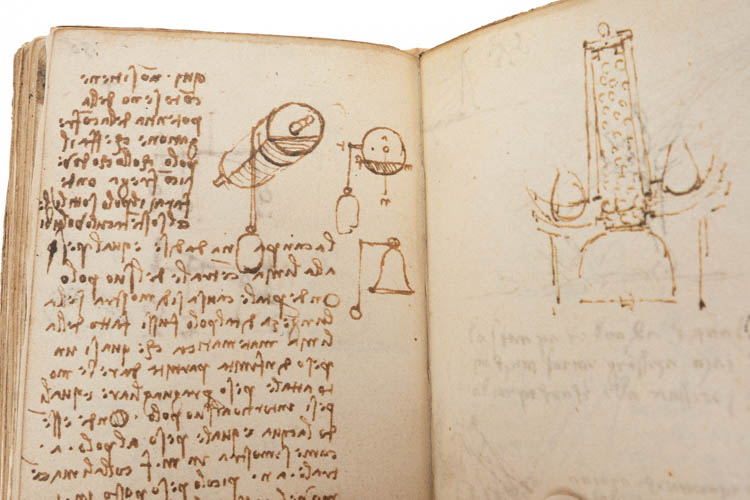
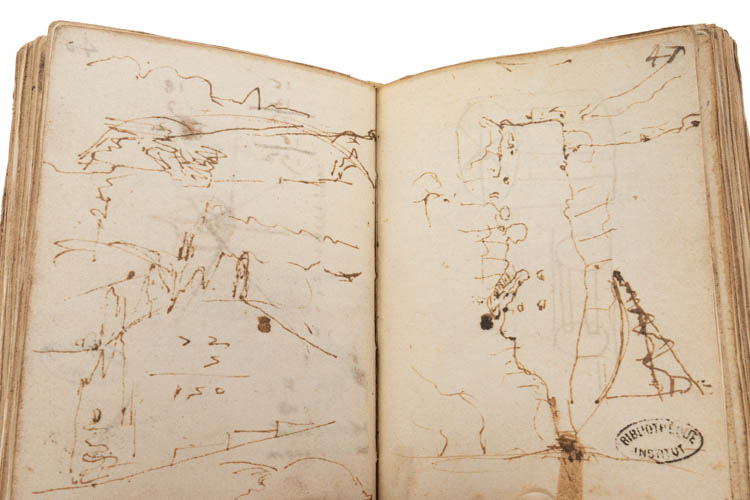
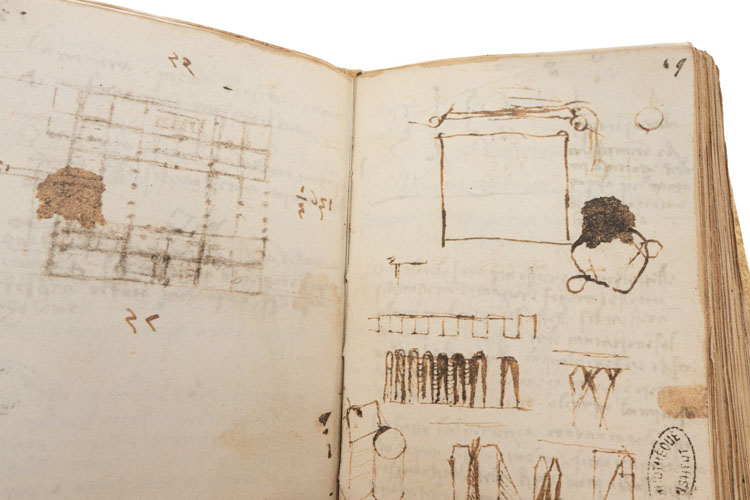
The manuscript’s light leather binding, trapezoidal flap, and unique labeling, including its classification as “I” and various other inscriptions, provide insight into its physical attributes and historical handling. The notes within suggest use over several years.
Manuscript I covers a wide range of topics, including geometry, water studies, mechanics, and Latin grammar, showcasing Leonardo’s diverse interests and methodological approaches to learning and documenting his observations.
The manuscript contains extensive studies on water and mechanics, reflecting Leonardo’s ongoing fascination with these subjects and his contributions to understanding physical laws and principles.
Dedicated space to geometry, picking up where another manuscript left off, demonstrates Leonardo’s engagement with Euclidean propositions and his attempt to apply mathematical principles to his observations.
The inclusion of Latin grammar notes, verb conjugations, and syntax studies indicates Leonardo’s efforts to improve his knowledge of Latin, likely influenced by his interactions with contemporary scholars.
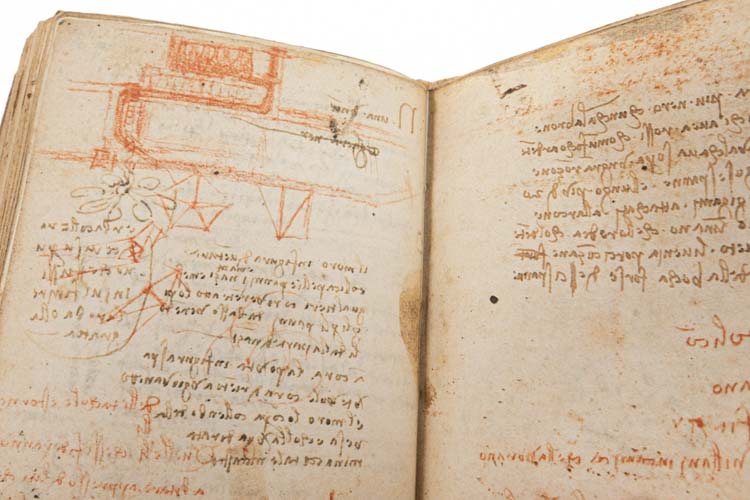
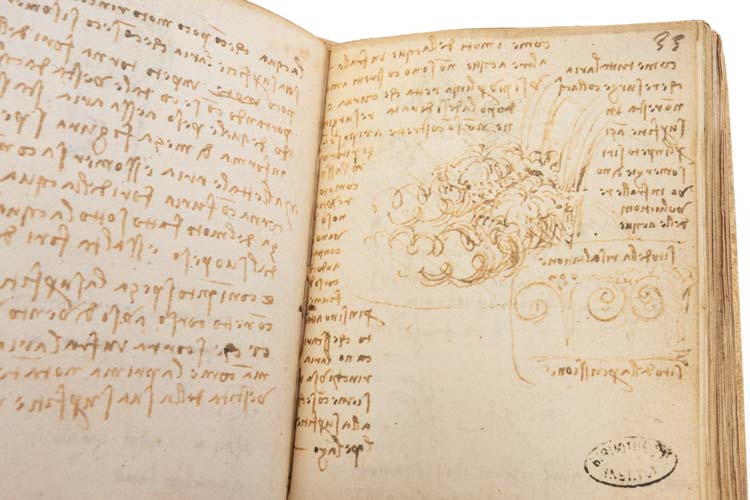
The manuscript includes undeciphered writings and drawings, hinting at Leonardo’s experimentation with different scripts or possibly encoding information, adding an element of mystery to his work.
Manuscript K
(cc. 128, mm. 96 x 65) Manuscript K is composed of three original notebooks (referred to as K¹, K², and K³), totaling 128 pages distributed across quires of 16 sheets each. Their sizes are consistent with the sedicesimo format, albeit with slight variations in dimensions, demonstrating a meticulous approach to organization and presentation.
Initially part of Francesco Melzi’s inheritance of Leonardo’s works, these notebooks later entered Pompeo Leoni’s collection, where they were systematically catalogued with both numerical and alphabetical codes, indicating Leoni’s effort to catalog and preserve Leonardo’s manuscripts systematically.
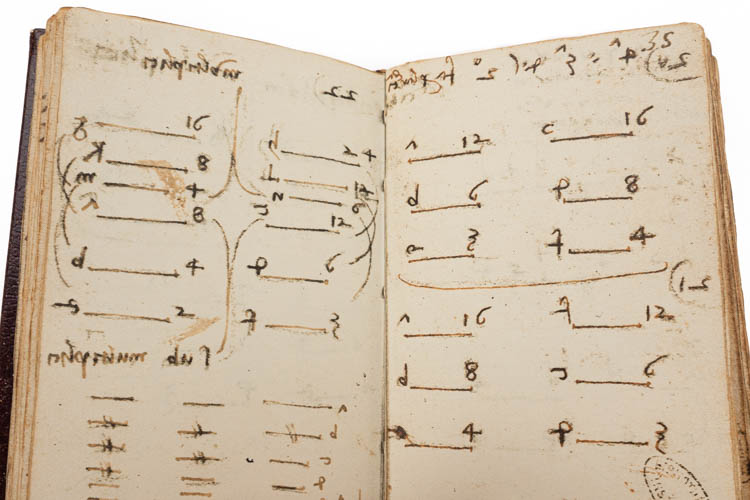
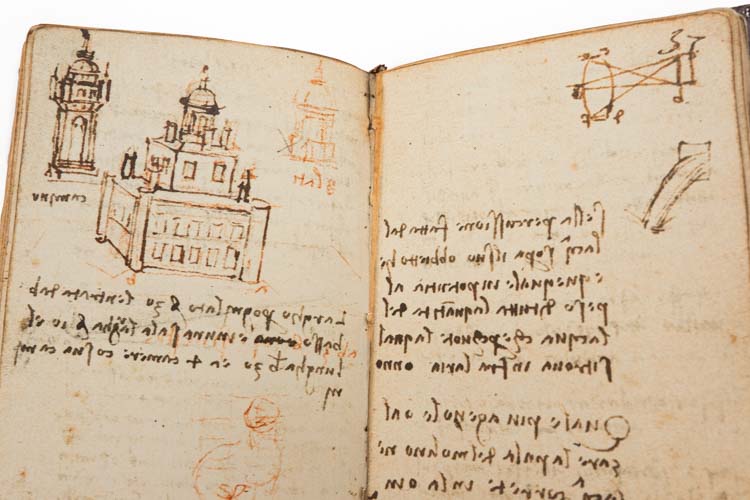
The manuscripts exhibit unique numbering anomalies, such as a skipped page number corrected to “18 bis” in K¹, and a disorganized first quire in K², which was later corrected during binding. These peculiarities offer insights into the challenges and methods of manuscript organization in the posthumous handling of Leonardo’s works.
Unlike other Leonardo manuscripts that transitioned from the Leoni collection to the Arconati collection, Manuscript K was donated by Count Orazio Archinti to the Biblioteca Ambrosiana in 1674, showcasing a distinct pathway in the preservation and dissemination of Leonardo’s works.
The manuscript was bound in red leather with gold decorations, a testament to the esteem in which Leonardo’s works were held by collectors and scholars, and to the efforts made to preserve them in an appropriately distinguished manner.
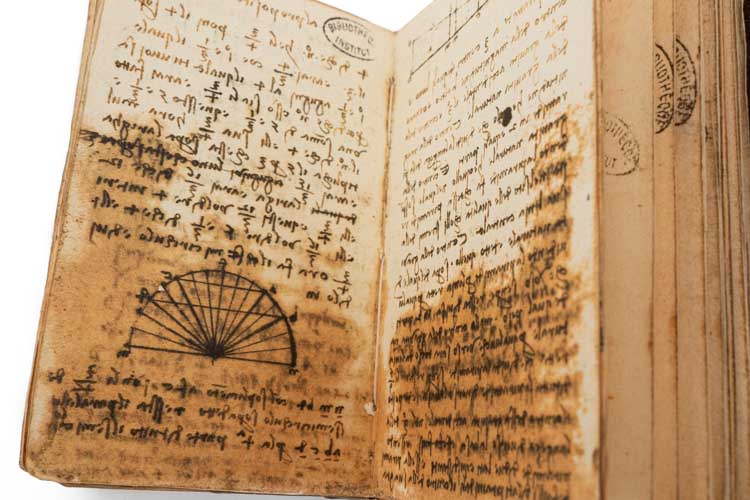
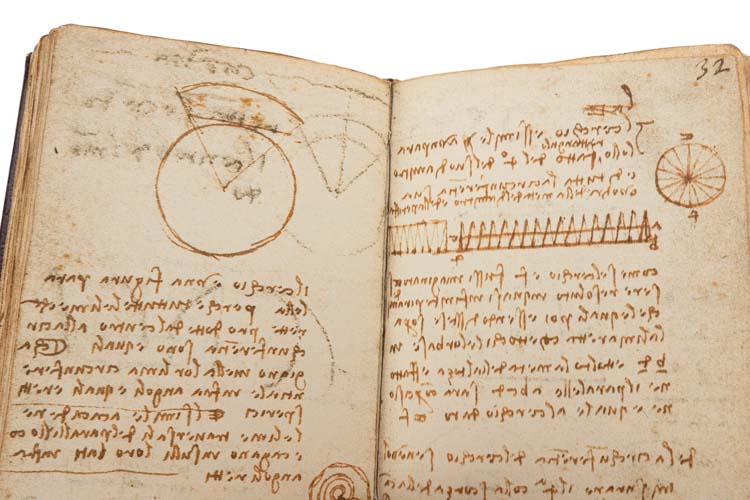
The notebook covers a wide range of subjects, from geometry and Euclidean studies to considerations on water, flight, anatomy, and mechanical devices. It contains extensive notes on geometry, particularly on the study of Euclid’s elements.
The manuscripts likely span a period of continued study and work by Leonardo, touching upon subjects that connect to other well-known manuscripts like the Codex Atlanticus and the Forster Codices, and reflecting Leonardo’s evolving interests and methodologies.
The inclusion of detailed anatomical sketches and considerations on optics within these notebooks underscores Leonardo’s pioneering contributions to these fields and his innovative approach to integrating art and science.
Through Leonardo’s notes on mechanics, flight, and water, Manuscript K provides valuable insights into his technical innovations and his practical approach to solving complex problems.
Manuscript L
(cc. 94, mm. 109 x 72) Manuscript L is part of the group of small notebooks in the sedicesimo format. It consists of six quires of eight bifolios each, totaling 96 pages, but due to a missing page and the first page being glued to the cover, the actual count is 94 pages.
The page numbering goes from 1 to 94, with annotations by a different hand inside the back cover confirming the page count as 94. Similar annotations are found in manuscripts C, G, E, and Leicester-Hammer, attributed to Melzi, suggesting a systematic approach to cataloging Leonardo’s works.
The manuscript originally had a blue cardboard cover, now partially preserved with remnants of a wrapping paper. Significant is the presence of Leonardo’s writing on the flaps glued inside the cover, indicating the manuscript was bound during Leonardo’s use. The cover also features various sigils, including “L” by Venturi in 1797 and “Q” by the Biblioteca Ambrosiana, marking its inclusion in their collection.
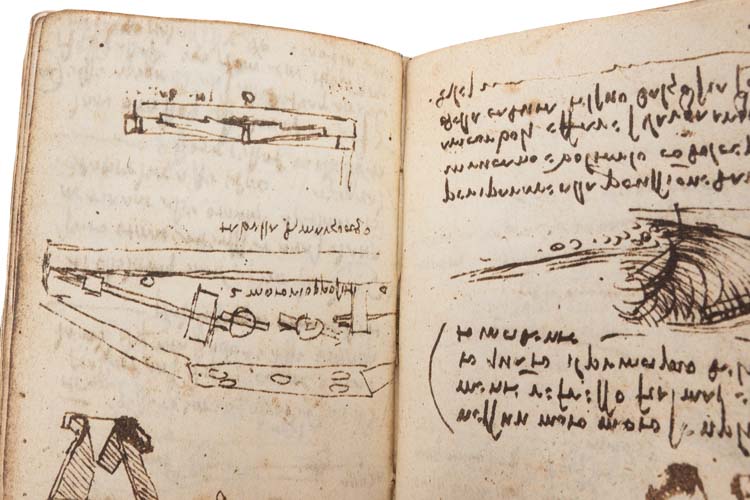
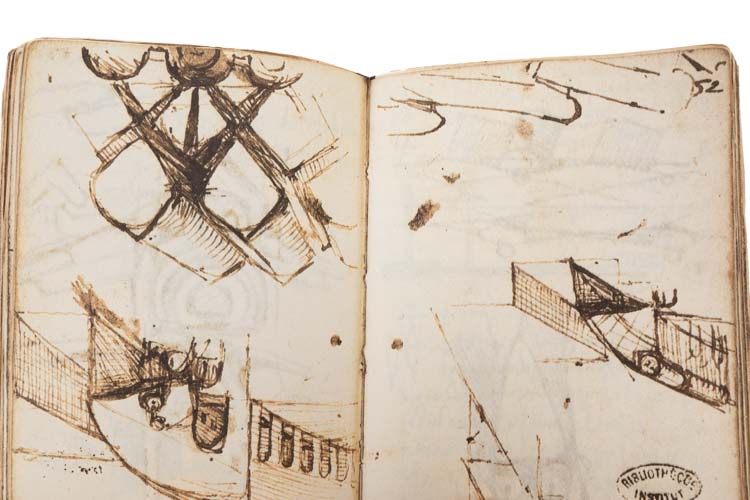
Notably, the manuscript contains a wide range of subjects, from mathematical figures and arithmetic operations to detailed notes on military architecture, particularly the fortifications of Romagna and Marche, reflecting Leonardo’s role as a military engineer for Cesare Borgia. Additionally, it includes studies on flight, reflecting Leonardo’s interest in mechanics and nature.
Manuscript L presents a complex chronological composition, encompassing notes from Leonardo’s time in Milan, including references to the Last Supper, to his period in Romagna under Cesare Borgia’s service. This spans from specific dates in 1502 to broader references to Leonardo’s projects and studies across these years.
The manuscript is rich in notes related to military fortifications and arithmetic exercises, showing Leonardo’s engagement with practical engineering problems and his evolving understanding of mathematics, influenced by his collaboration with Luca Pacioli.
Among the distinctive features are the detailed sketches of cities’ fortifications, a project proposal for a bridge from Pera to Constantinople, and reflections on arithmetic rules, showcasing Leonardo’s broad interests and innovative thinking.
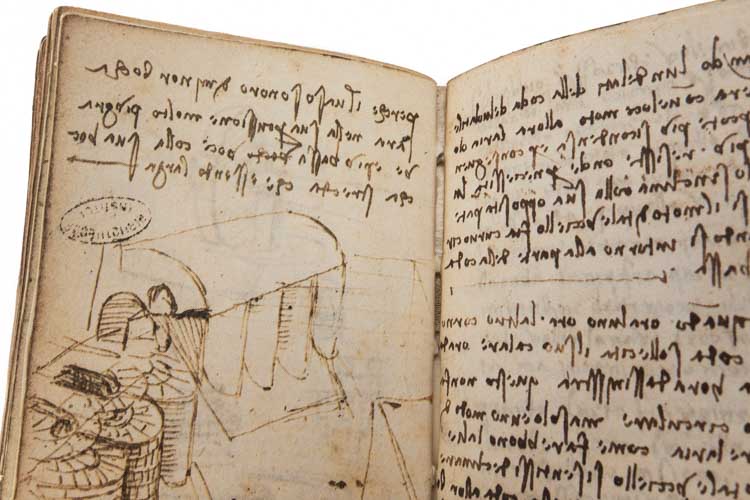
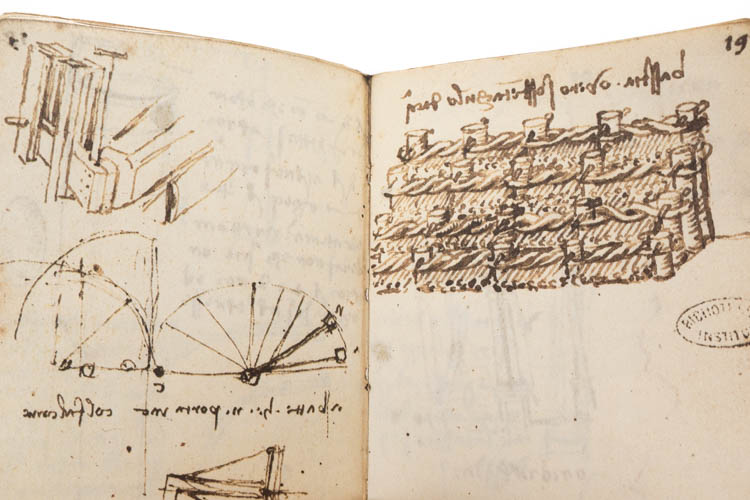
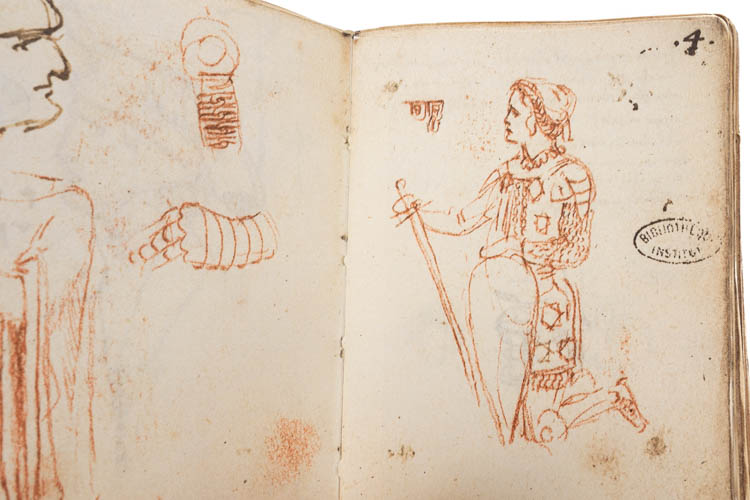
Manuscript L shares a common history with many of Leonardo’s manuscripts, transitioning from Melzi’s inheritance to Pompeo Leoni’s collection, then to Count Arconati, and finally donated to the Biblioteca Ambrosiana in 1637, marking its significant journey through history and preservation.
Manuscript M
(cc.94, mm. 109 x 72) Manuscript M, held by the Institut de France, is a paper manuscript containing 48 bifolios folded and sewn into a yellowish cardboard cover with an additional protective paper layer, partially worn away. The manuscript’s original structure is preserved, comprising five quires of sixteen pages each, plus another similar quire split into two parts.
The manuscript covers a wide range of subjects, including Euclidean geometry, the science of weights (mechanics), Aristotelian physics, the fall of bodies including liquids, and the resistance of mediums like air. It also contains notes on the military arts, technology, optics, allegorical drawings, and botanical studies.
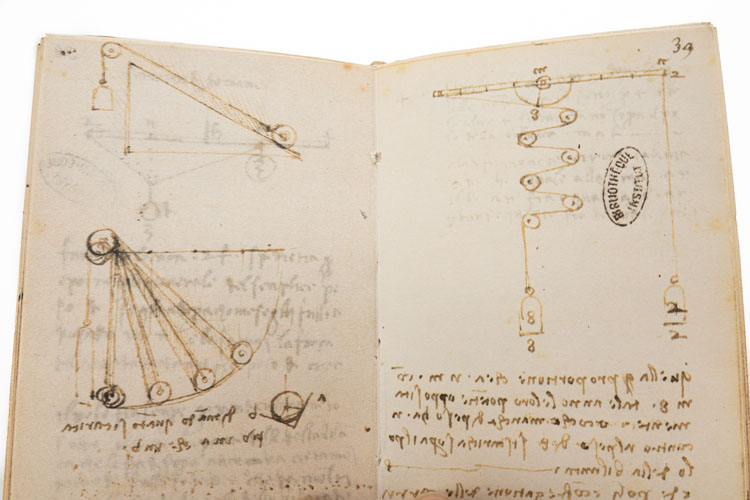
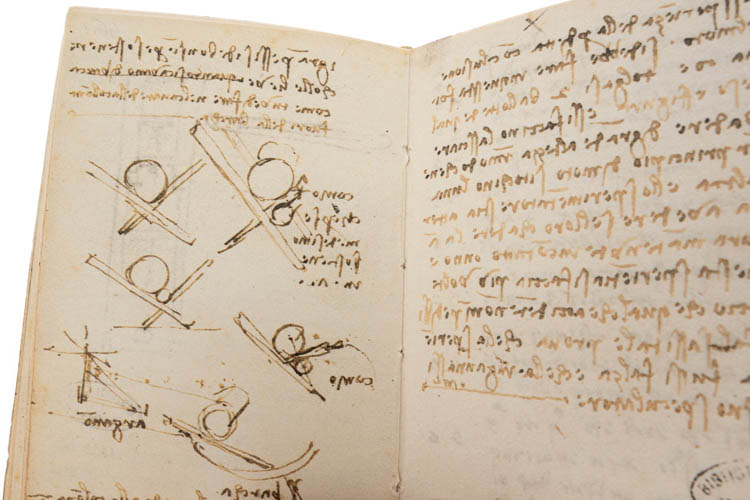
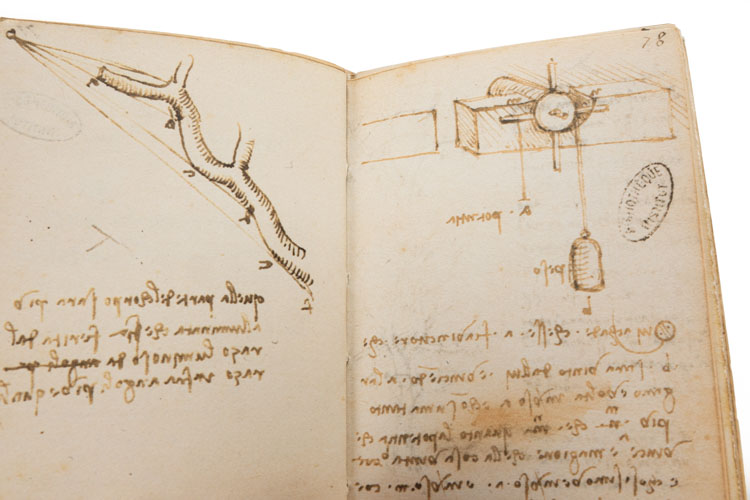
Manuscript M contains Leonardo’s pen-written notes on Euclidean propositions, showcasing his method of learning geometry, possibly with the assistance of Luca Pacioli. The manuscript illustrates Leonardo’s selective approach to Euclid, focusing on theorems with practical applications and often substituting geometric proofs with arithmetic ones.
It includes mathematical rules derived from Pacioli’s “Summa” and exercises in arithmetic progression, highlighting Leonardo’s fascination with the infinite divisibility of matter and his use of mathematical calculation to explore physical phenomena.
The manuscript reflects Leonardo’s engagement with medieval science of weights (mechanics) and Aristotelian physics, particularly in the context of the movement of heavy bodies and the resistance offered by mediums like air. Leonardo’s observations and experiments challenge and expand upon these traditional theories, emphasizing the role of experience and mathematical reasoning.
Leonardo investigates the acceleration and velocity of falling bodies, applying mathematical models to understand their motion and the impact of air resistance. He explores the behavior of liquids in free fall, questioning and refining ancient and medieval theories based on his observations.
Giovanni’s Top Secret Mission to France
Following the roaring success of the Giunti facsimile edition back in the late 80s, another daring publisher has taken on the challenge of recreating Leonardo’s twelve notebooks. Our very own Giovanni lent his expertise to Faksimile Verlag, getting up close and personal with the very pages touched by the hand of Leonardo Da Vinci himself.
The result? A revamped edition released in stylish sets of three notebooks per box, complete with insightful commentary in both German and English. Now, all aficionados of art and the genius of Leonardo can immerse themselves in the closest thing to the real deal.
Fun Facts: In the end, Giovanni’s journey into the world of Leonardo da Vinci’s original sketchbooks was nothing short of extraordinary. The meticulous care with which these invaluable treasures are preserved is a testament to their historical significance. From the controlled temperature environments to the secure vaults, every detail is designed to protect these masterpieces for future generations. The entire process of measuring and color-proofing the sketchbooks underscored the immense value and reverence placed on da Vinci’s works.
Entering the caveaux was an experience in itself. Giovanni, along with a select group of experts, underwent weight checks and retina scans before and after each visit to the notebooks. He marveled at the number of keys and secret codes, feeling like he was on a top-secret mission.
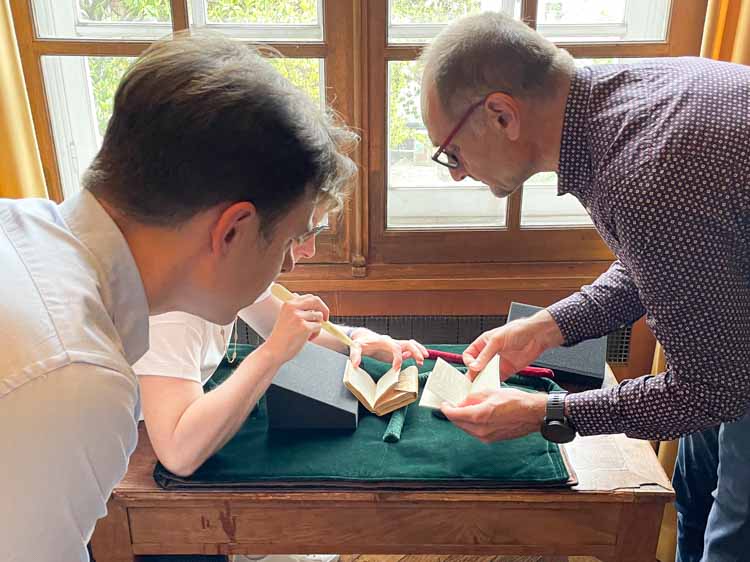
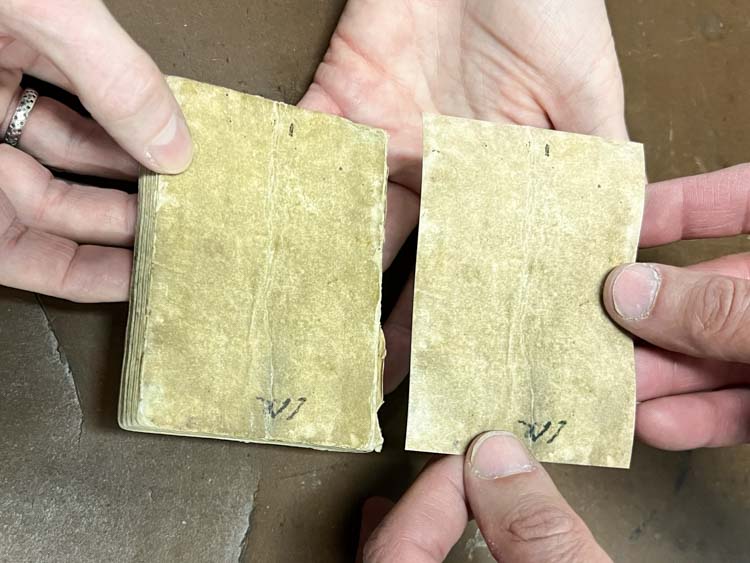
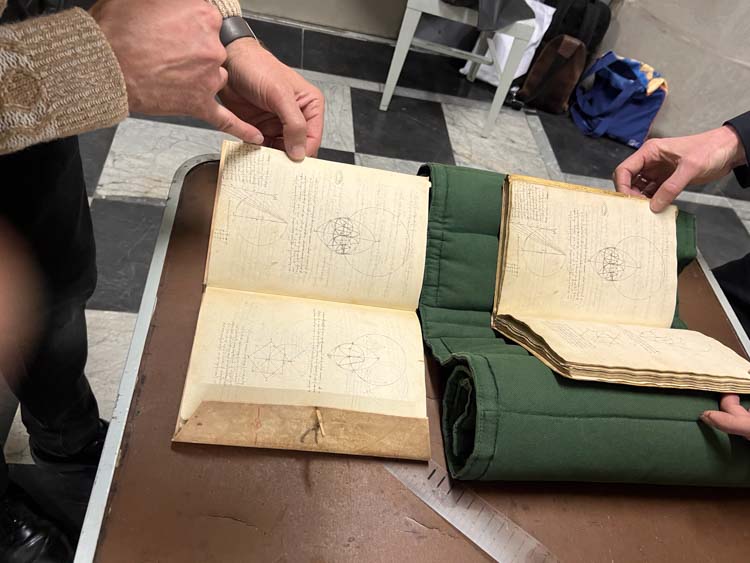
Collaborating with the publisher to create the new facsimile edition was a privilege and an adventure Giovanni will never forget. His firsthand experience with these legendary sketchbooks has added a profound depth to the facsimile edition, ensuring that da Vinci’s genius can be appreciated by many for years to come.


